The town of Lenox in the state of Massachusetts is a charming place. At least this is how it is often described in guidebooks and brochures, which is regularly accompanied with pretty photos with blue sky and sunlit details. However, when Daniela and I arrived here as a part of our trip by a rented car around the west sections of New England in the USA, it was cloudy and it drizzled. Admittedly, the little town still looked charming and the lack of the colour from the sky was compensated by the autumn leaves.
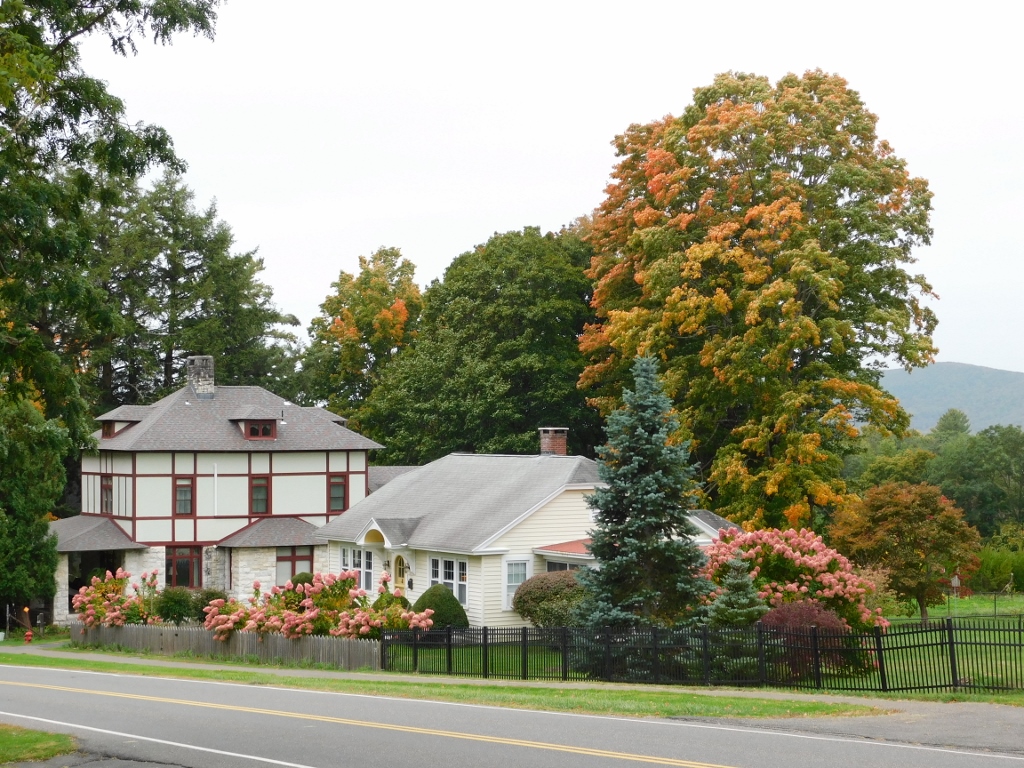 Lenox, MA
Lenox, MA
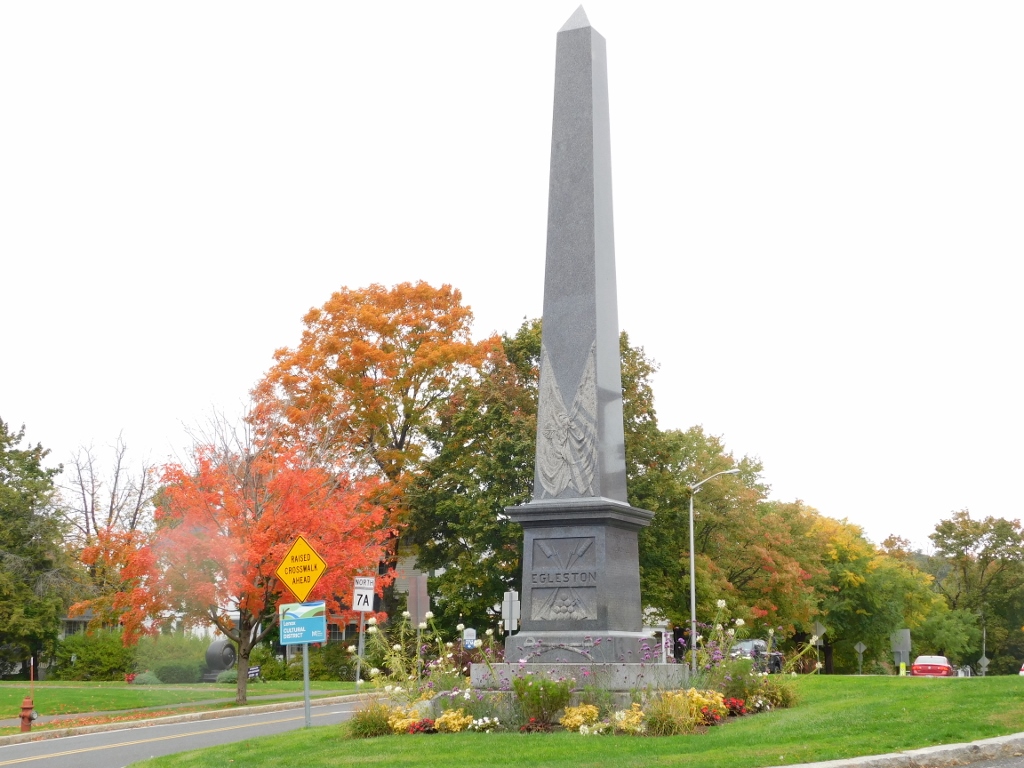 Lenox, MA
Lenox, MA
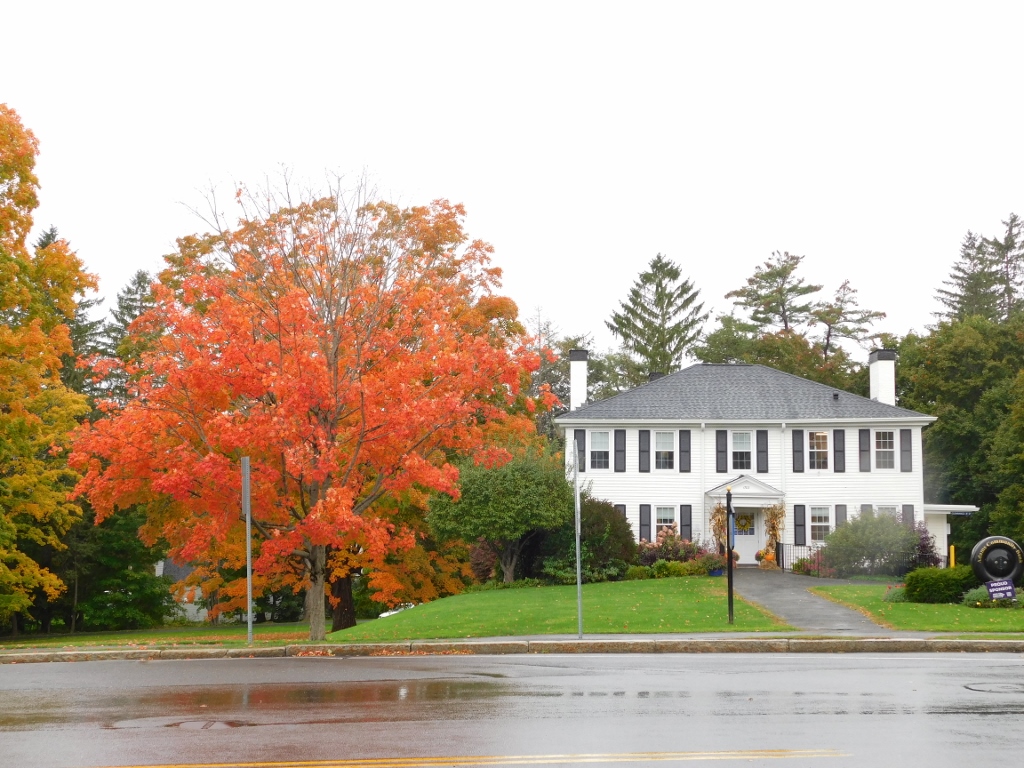 Lenox, MA
Lenox, MA
We parked the car here and headed for a walk. Close to the main crossroad in the town there is the Town Hall, as well as the building of the former Curtis Hotel built in 1829, while nearby there is also the Lenox Library located in the former courthouse building from 1815.
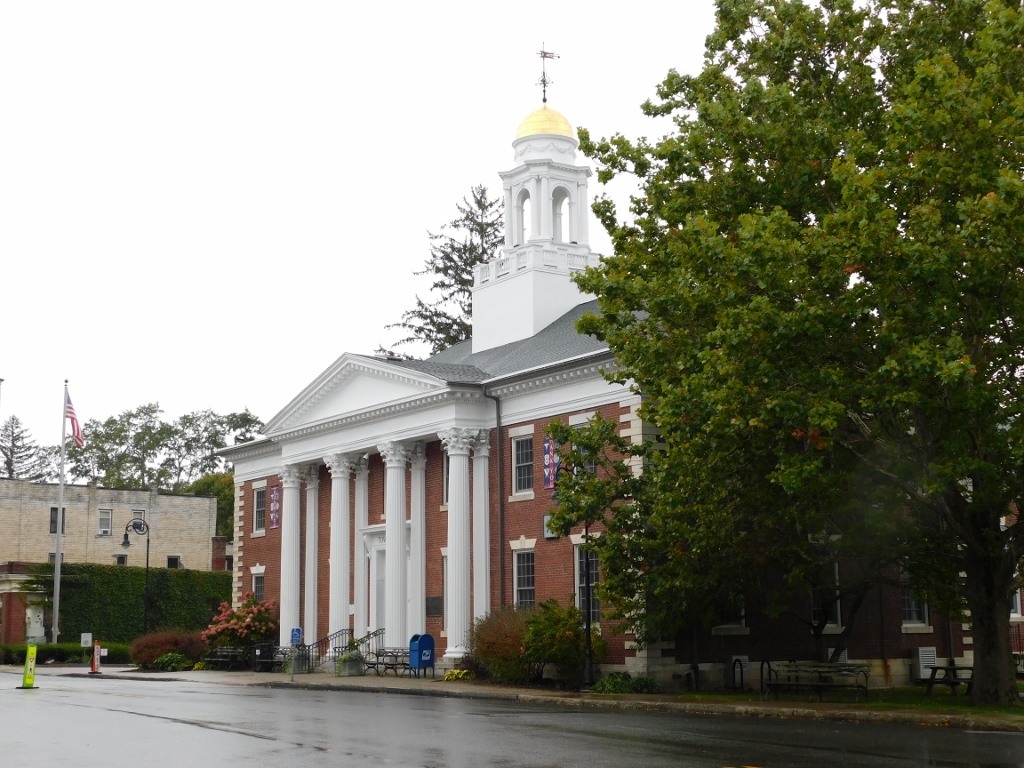 Lenox, MA
Lenox, MA
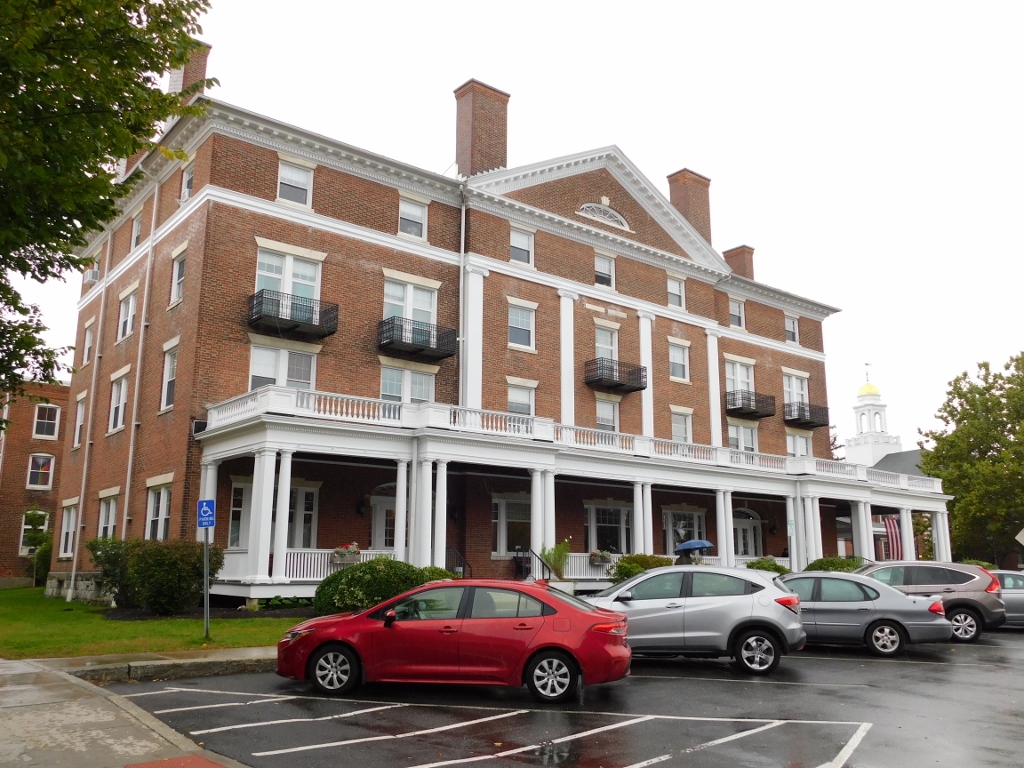 Lenox, MA
Lenox, MA
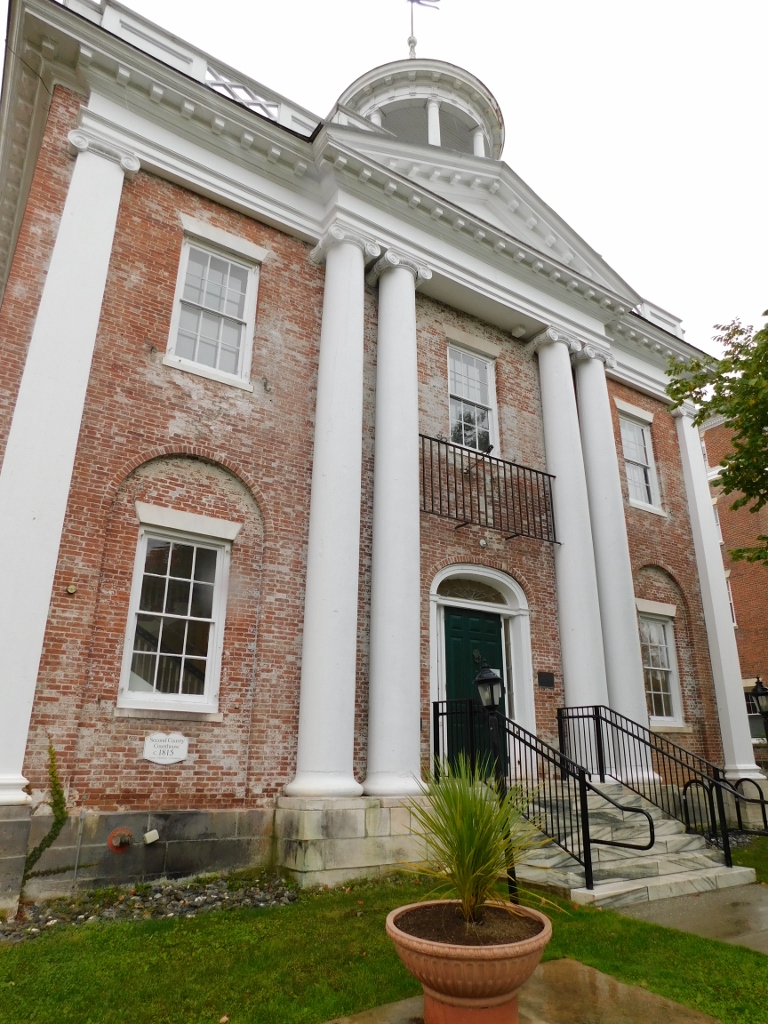 Lenox, MA
Lenox, MA
By this time, it started to rain more heavily and so we entered the streets of central Lenox where we found an exceptional place for making breaks. It was a fantastic pastry shop/bakery. It all looked alluring, but we both resisted the temptation and did not eat everything that was on offer.
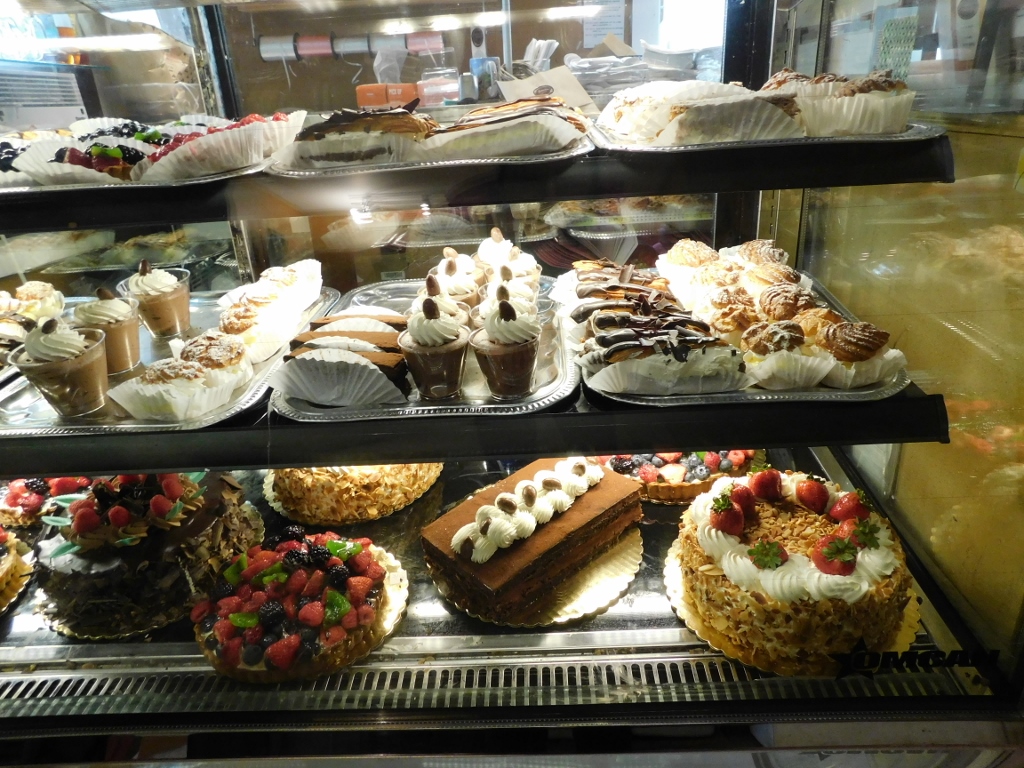 Cakes in Lenox
Cakes in Lenox
By the time we finished with the cakes and the coffee, it had stopped raining, but the situation was not promising. It seemed it would start raining again any moment now.
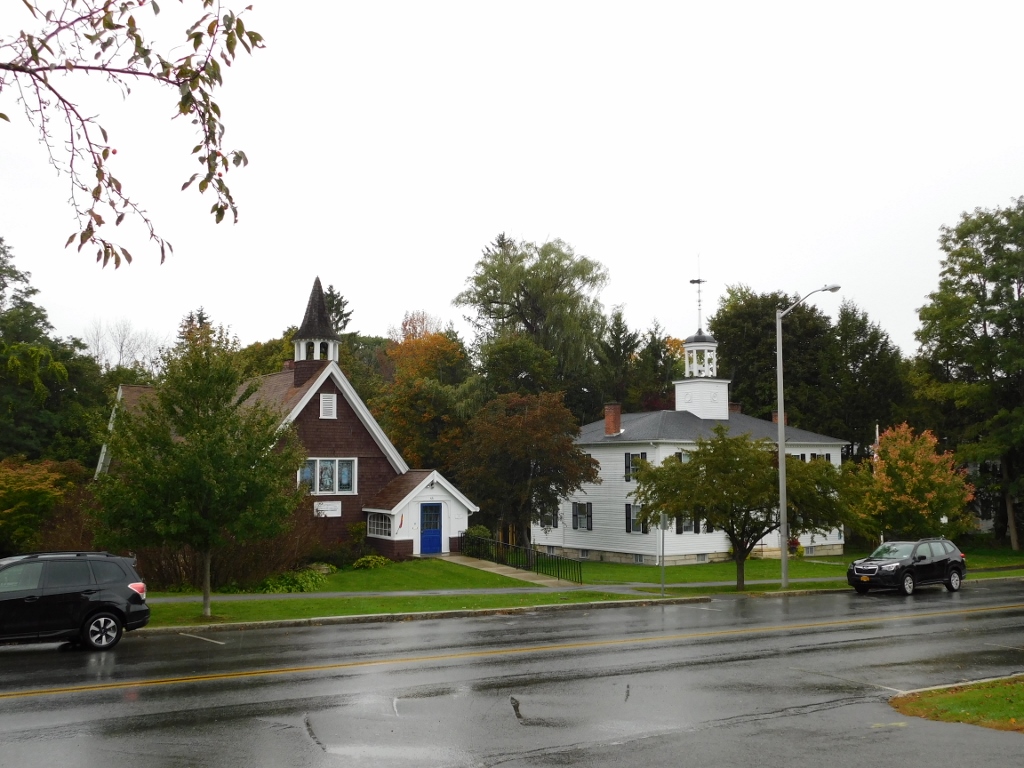 Lenox, MA
Lenox, MA
That’s why we just returned to the main street and back to the car, after which we continued with our travel northwards, towards the town of Pittsfield, but without getting in. Instead, we drove some 10 km further to the west to a village. But, this is not a village in the proper sense of meaning or a village that functions as such today. This was the Hancock Shaker Village.
 Hancock Shaker Village
Hancock Shaker Village
As a Christian sect, the Shakers were founded in England around the middle of the 18th century and already in 1774 the first Shaker community was founded in colonial America. They lived in separate communities, communes, that were characterised by a simple rural lifestyle. In addition to having their interpretation of Christianity as the backbone of their functioning, they are renowned for not only advocating, but practicing gender equality, celibacy, pacifism, etc.
At their summit, around the middle of the 19th century, there were around 3000 Shakers who lived in 23 communities, while today, there is only one such active Shaker community in the US state of Maine. It is interesting that it was founded back in 1794.
This one, on the territory of the village of Hancock, which it was named after, was founded in 1790, but it was closed in 1960. Over time, it was turned into an open-air museum.
In order to visit the village, you first need to get to the Visitor Centre where you enter a small area with display of various objects and tools used by the Shakers that are shown here as artistically presented objects. The two of us just passed there, without lingering, since we were primarily interested in seeing parts of the former Shaker community.
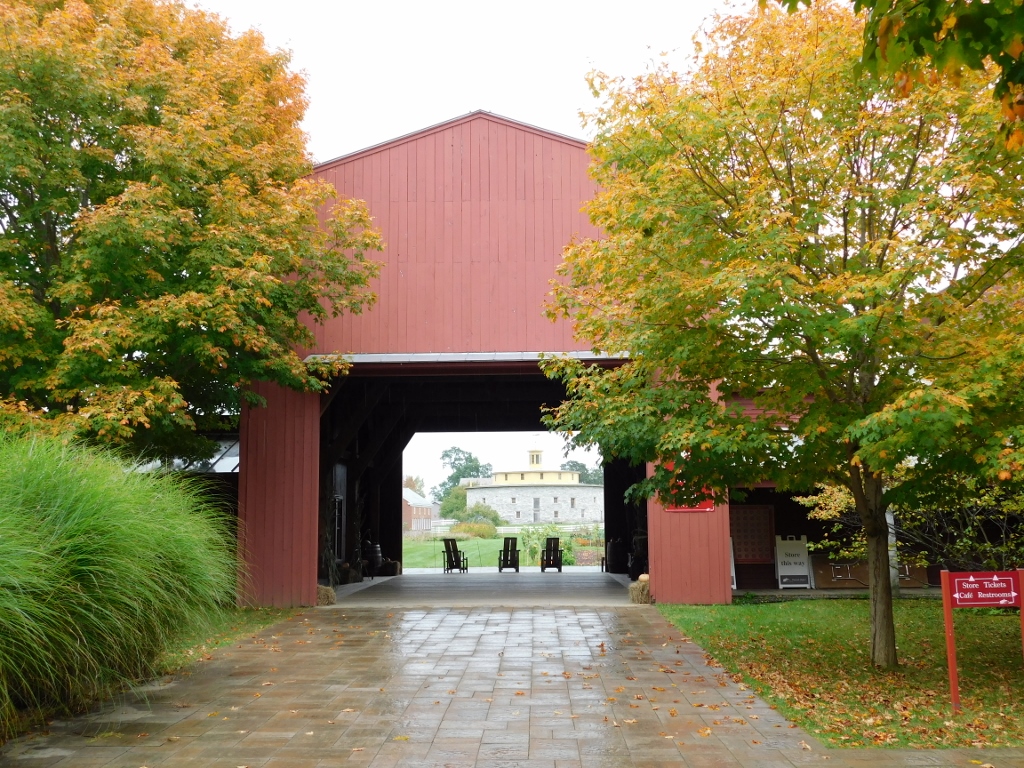 Hancock Shaker Village
Hancock Shaker Village
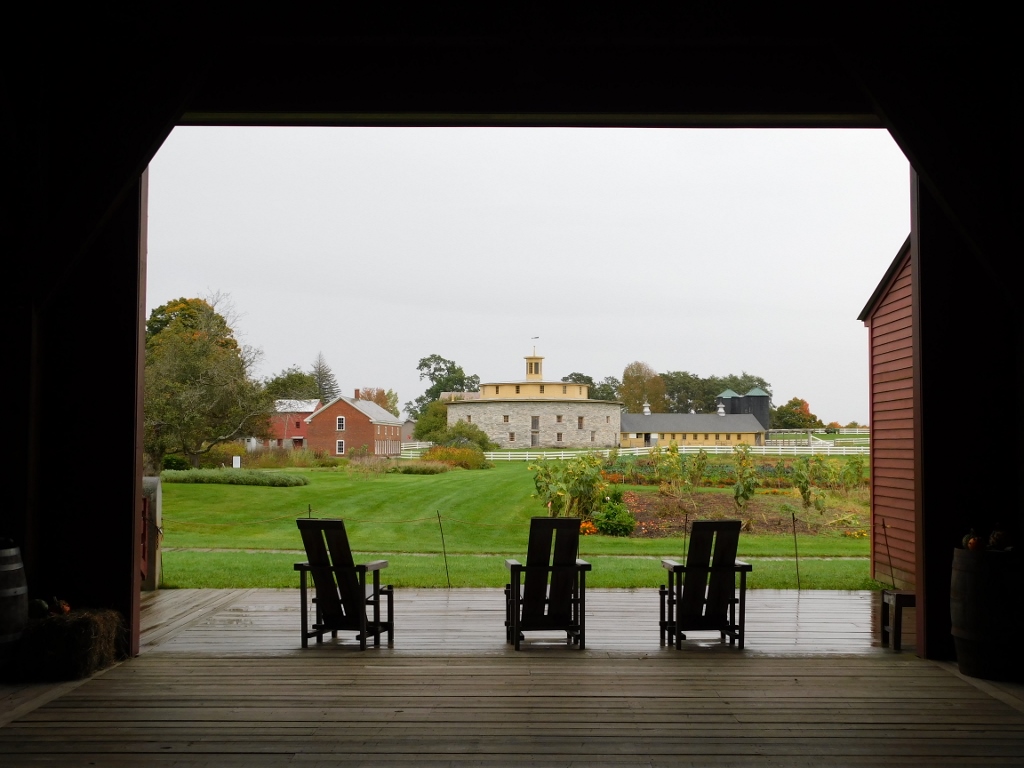 Hancock Shaker Village
Hancock Shaker Village
Once you leave the Visitor Centre area, there is a wooden board path leading to the main sections of the property. Straight ahead there are gardens that are cultivated event today.
 Hancock Shaker Village
Hancock Shaker Village
In the photo above, behind the gardens in the middle, the most striking is a round building made of stone and that was a barn, while to the left there is the Brick Poultry House. This is seen better in the photo below.
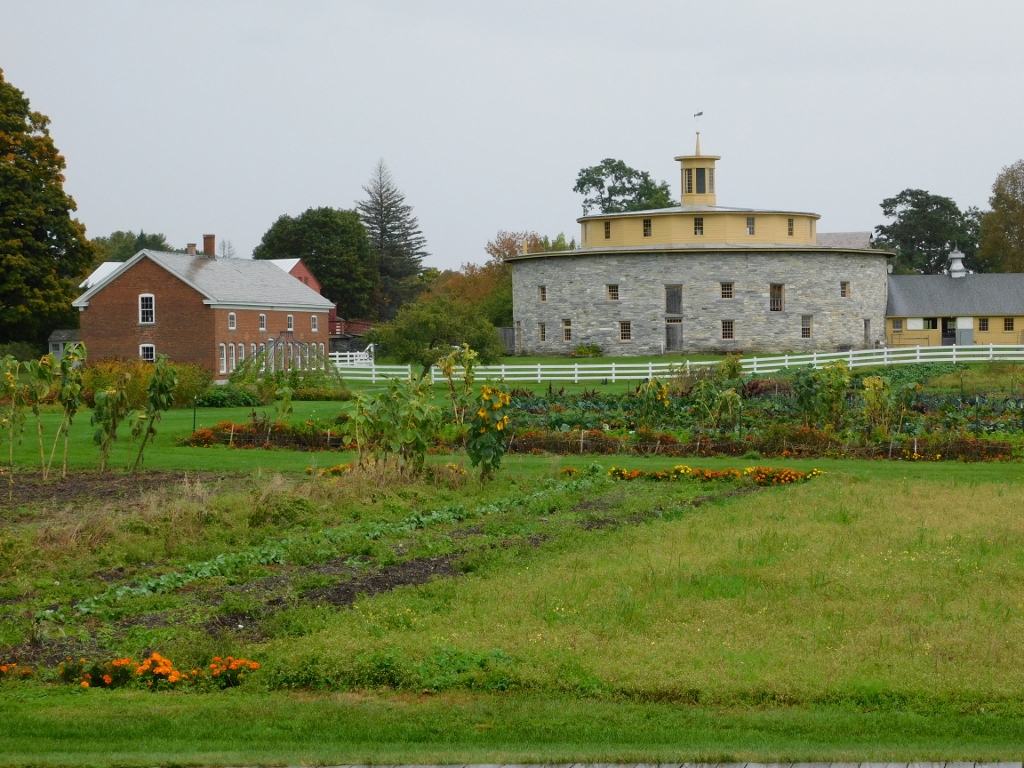 Hancock Shaker Village
Hancock Shaker Village
In addition to the Brick Poultry House, the next photo shows on the left-hand side a smaller gray house, Garden Tool Shed, as well as significantly bigger red houses in the back.
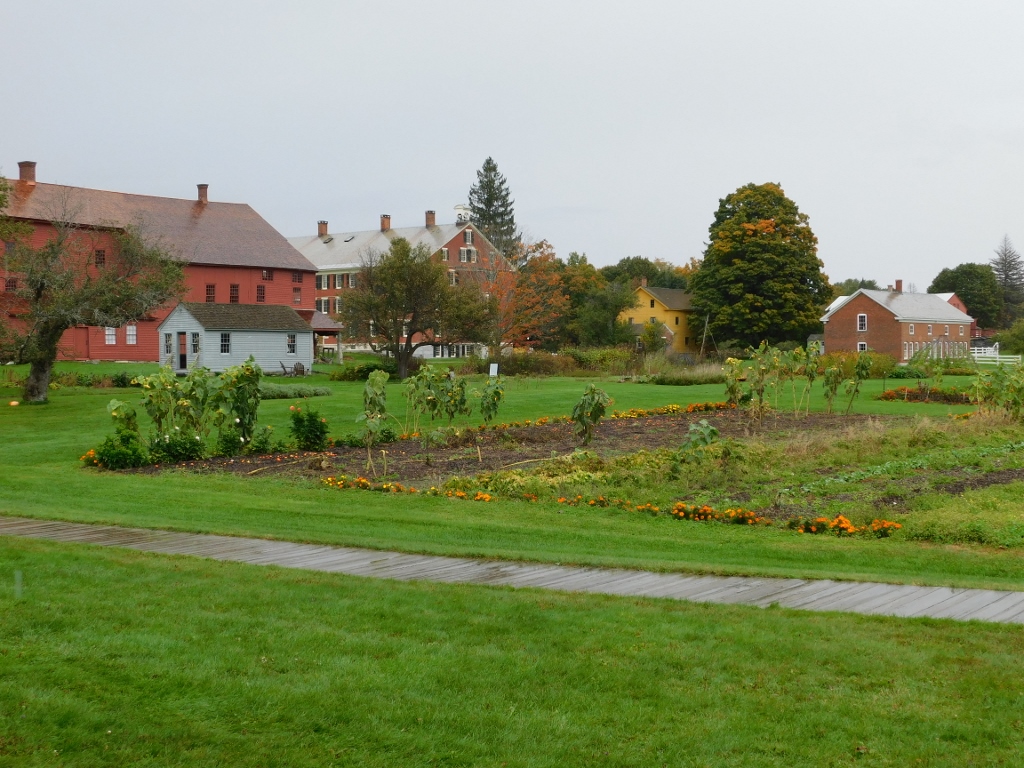 Hancock Shaker Village
Hancock Shaker Village
I will say a little more about these bigger houses when I talk about visiting them. For the time being, I just walked past them. These are the Laundry and Machine Shop, left, and the Brick Dwelling, right.
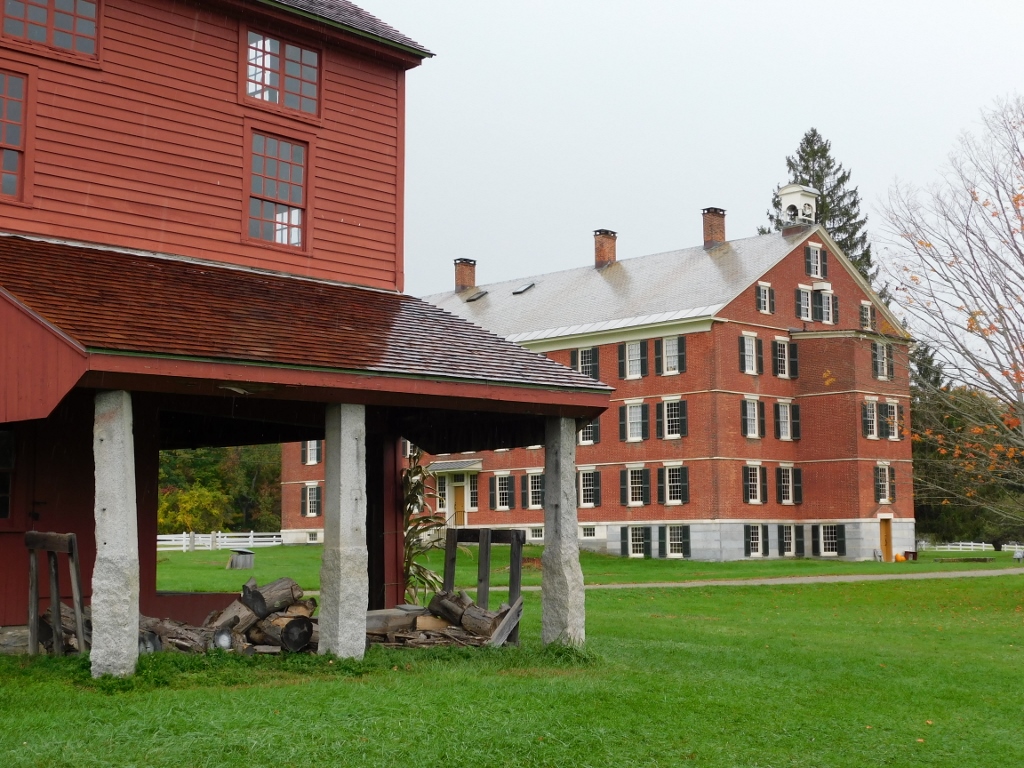 Hancock Shaker Village
Hancock Shaker Village
Right now I was more interested in the Round Stone Barn, but along the way I also passed by the Brick Poultry House, to the left in the photo below.
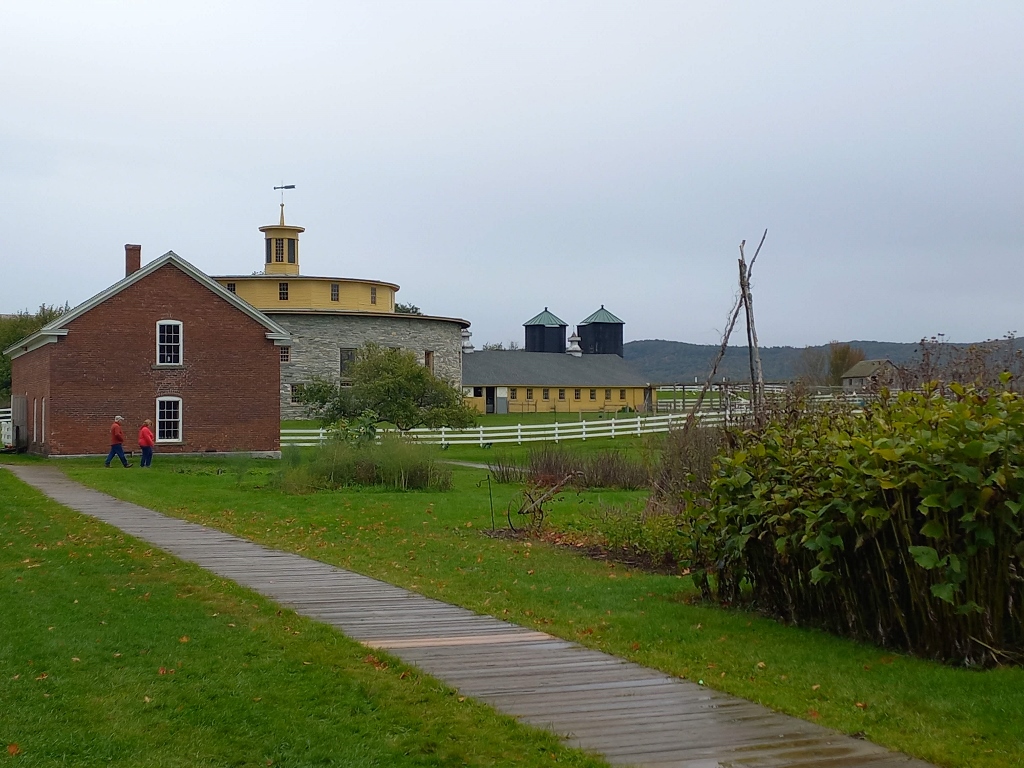 Hancock Shaker Village
Hancock Shaker Village
This house was built in 1878 and like in all other buildings, here too you can see a display of old photographs and objects that show the way in which the specific building was used during the Shaker times.
Since the Shakers earned a good deal of income for their community by selling poultry, eggs and feathers, raising chicken was very important and that’s why they paid attention to various details such as the south-facing windows being bigger than the rest. The reason for this is that during the winter months you provide the “passive solar gain” in this way, which encourages chicken to lay eggs even during shorter winter days. During summers, the chicken were, of course, let outside, but during winters they were kept in this house where they also had a furnace to heat additionally the space for the chicken.
Now I headed for the area with the barn and the accompanying structures.
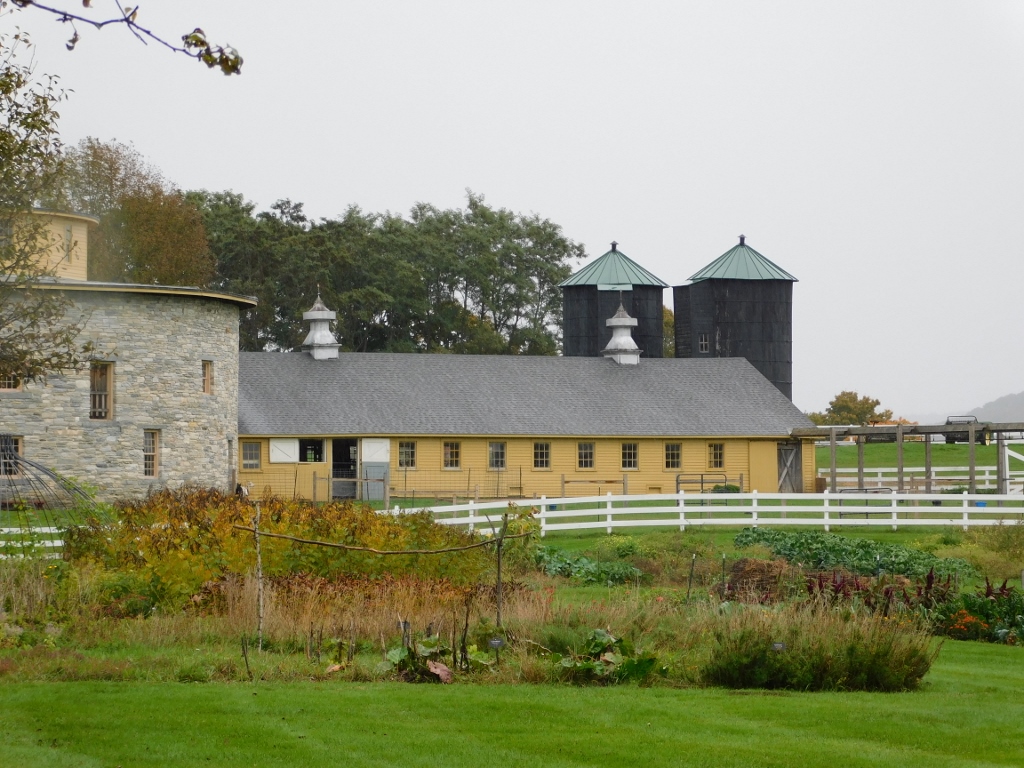 Hancock Shaker Village
Hancock Shaker Village
The Round Stone Barn was built in 1826 and it is round for several reasons, one of them being that this is the most functional shape for the purpose.
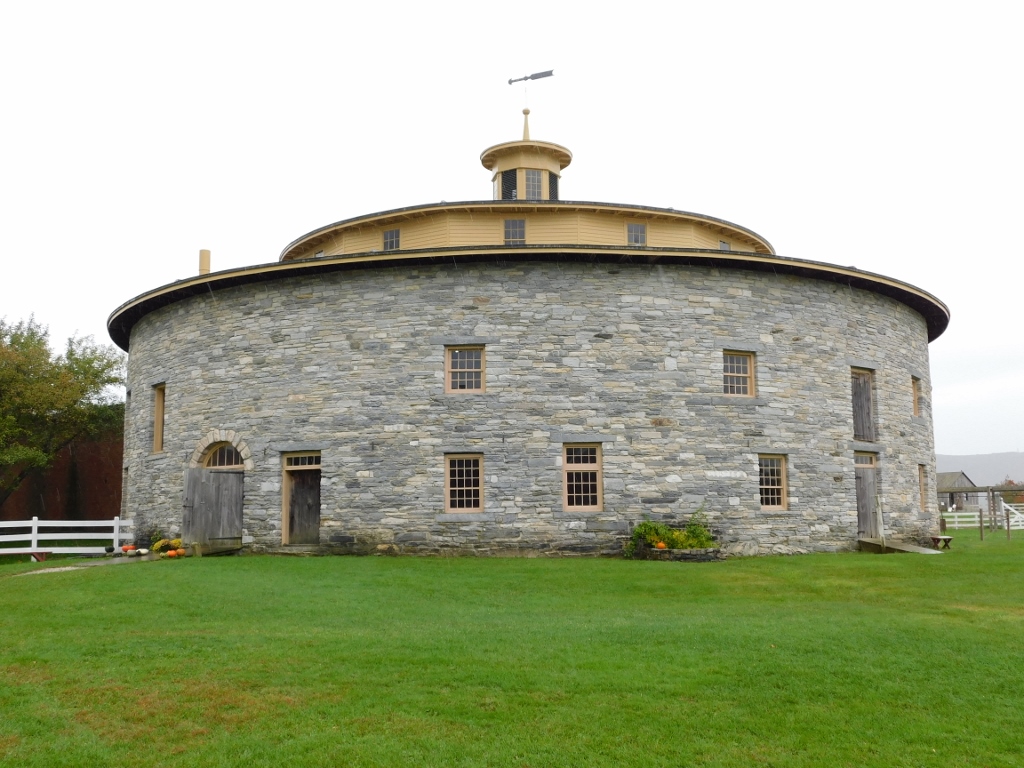 Round Stone Barn
Round Stone Barn
Regardless of the stone facade, everything inside is made of wood.
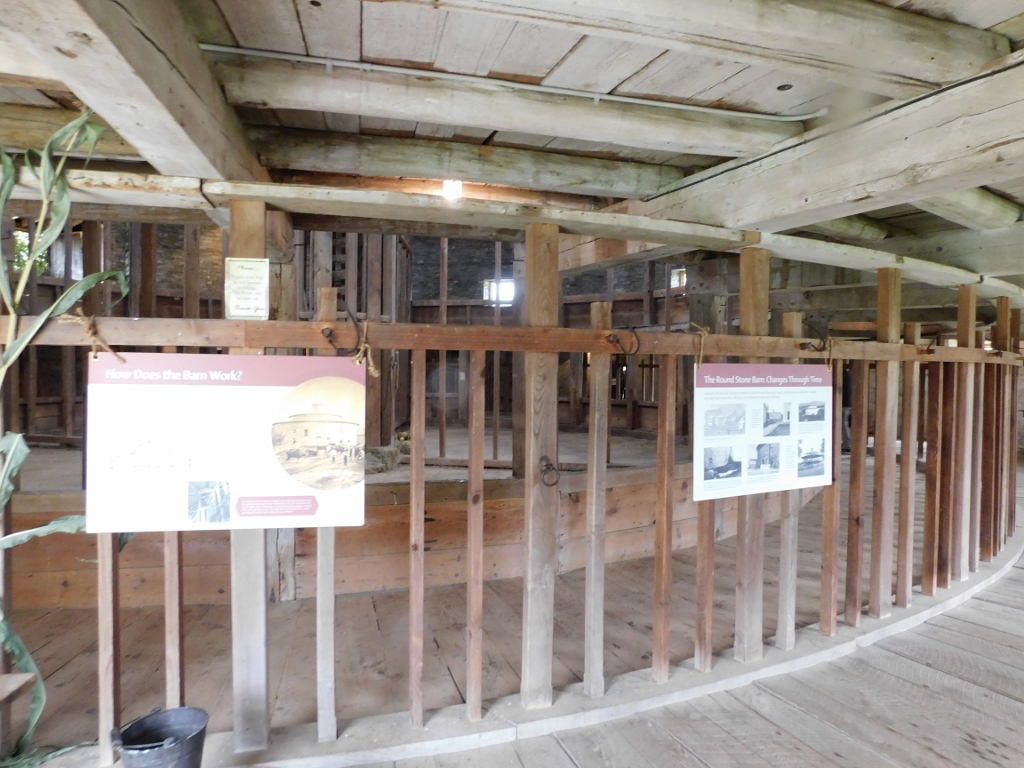 Round Stone Barn, a detail
Round Stone Barn, a detail
In the case of this building, too, there is an interesting story about the organisation of the interior space that was divided into four zones, four rings, so to speak. The middle zone provided ventilation, lest the hay developed mould or spontaneously got combusted. The second ring was used for storing the hay that was thrown in there from the upper floor where carts, reaching this level by a ramp, could go in circles. The third zone was the passage for the brethren, as was the term for the male members of the community, who got there in order to feed the cattle and approach them during milking. The cows were placed in the fourth zone, the outside ring. This structure could house up to 70 cows.
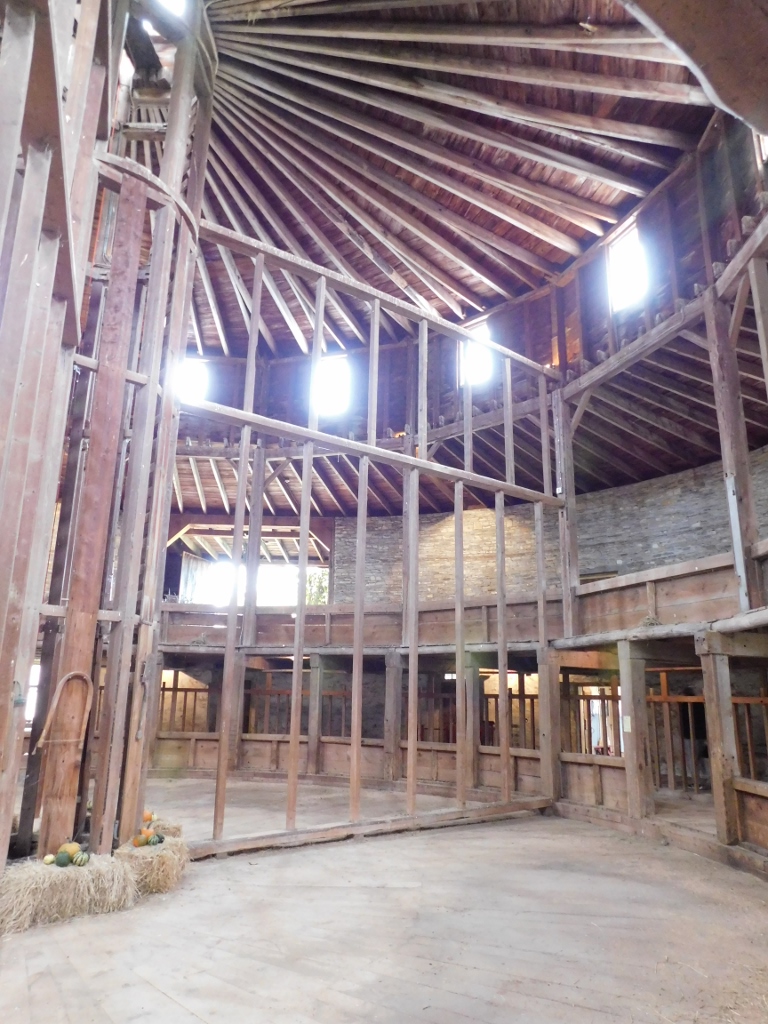 Round Stone Barn, a detail
Round Stone Barn, a detail
It needs to be mentioned that various seemingly tiny details were applied during the construction, but these details ensured that the manure could be removed quickly and easily, and also that the buckets used for milk would not touch the manure at any point. The Shakers were famous for their impeccable hygiene that permeated all parts of the settlement.
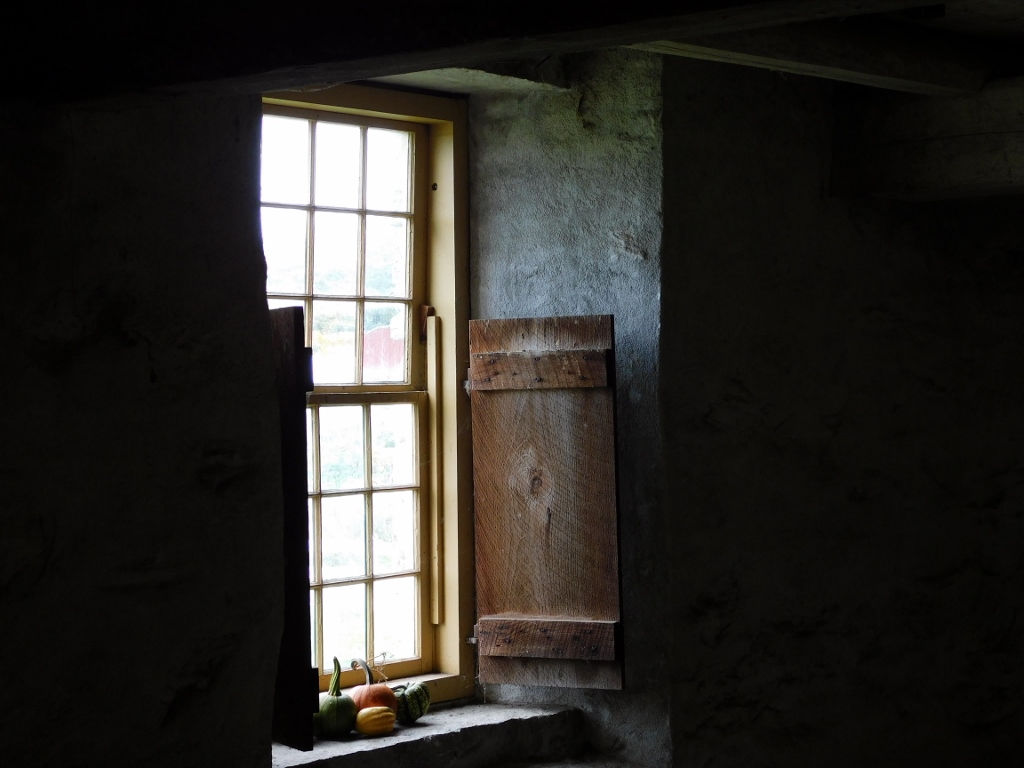 Round Stone Barn, a detail
Round Stone Barn, a detail
From the barn, I moved on to the Dairy Ell with which the barn is connected (it is the yellow building in the photo below) and from there I got out towards the fenced-off parts where some goats were kept, but I did not deal with this area, opting instead to walk around the barn and the auxiliary structures in order to see the details better.
 Hancock Shaker Village
Hancock Shaker Village
 Hancock Shaker Village
Hancock Shaker Village
When you approach the round barn from the back side, you can see the ramp that was used for the carts with hay to go up and come down. This can be seen in the photo above on the left-hand side (where on the right-hand side is a gray building called the Discovery Barn which is adjacent to another gray building) and it can be seen even better in the photo below.
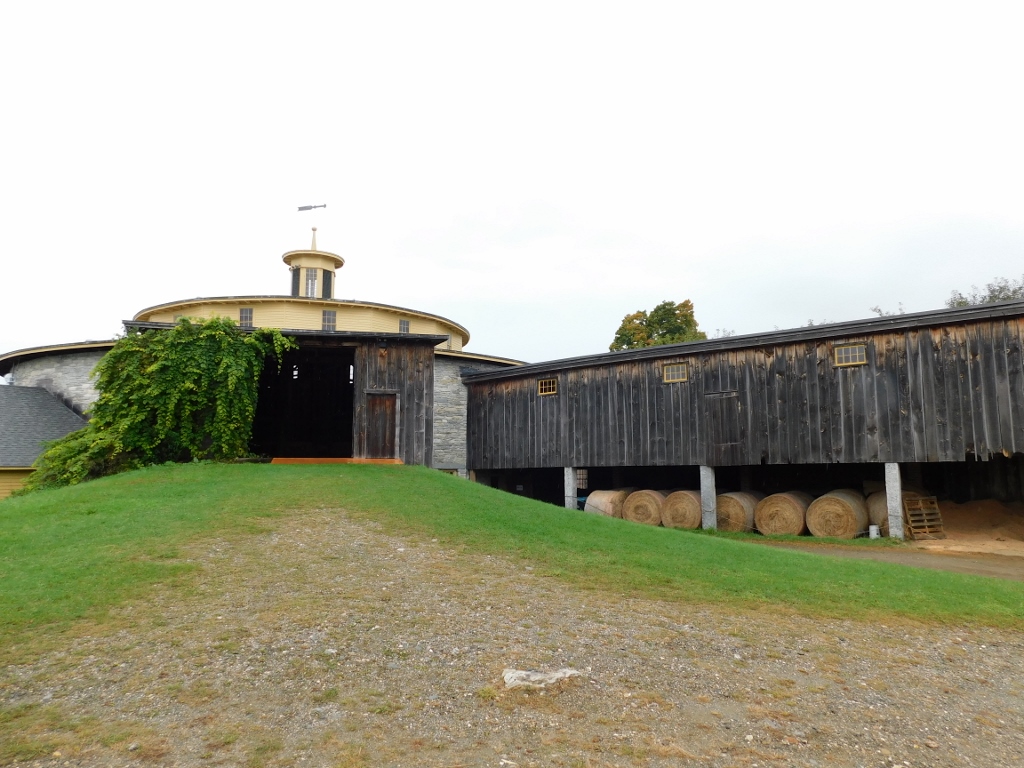 Hancock Shaker Village
Hancock Shaker Village
As for the Discovery Barn, it was built in 1939, as an addition to a barn from 1910 (that’s the other gray building in the penultimate photo above). It is interesting that this barn was built in line with some patented innovative design from Iowa in order to ensure efficient and hygienic milk production. What I want to say with this is that the Shakers were not some ignorant cultists, but rather not only did they themselves come up with innovative ways of working and functioning at an agricultural farm, but they also followed the trends from the other parts of the USA. Nowadays, this building is used for the practical training dealing with animal husbandry.
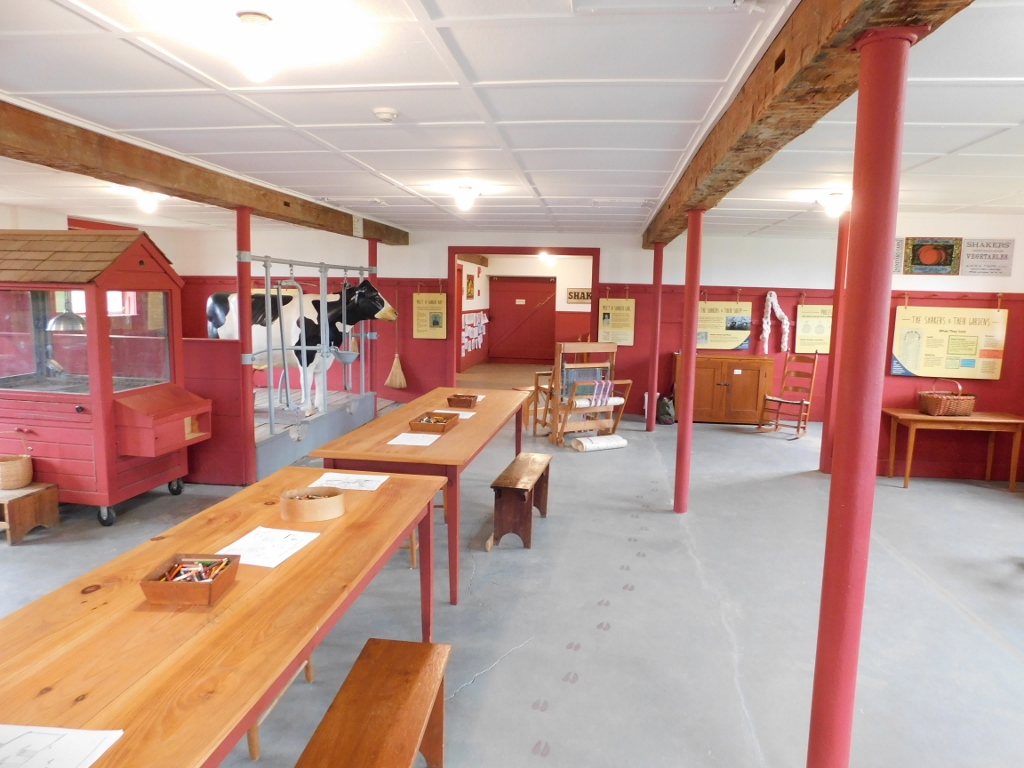 Discovery Barn, the interior
Discovery Barn, the interior
In the continuation of my sightseeing I also reached Tannery and the Ice House.
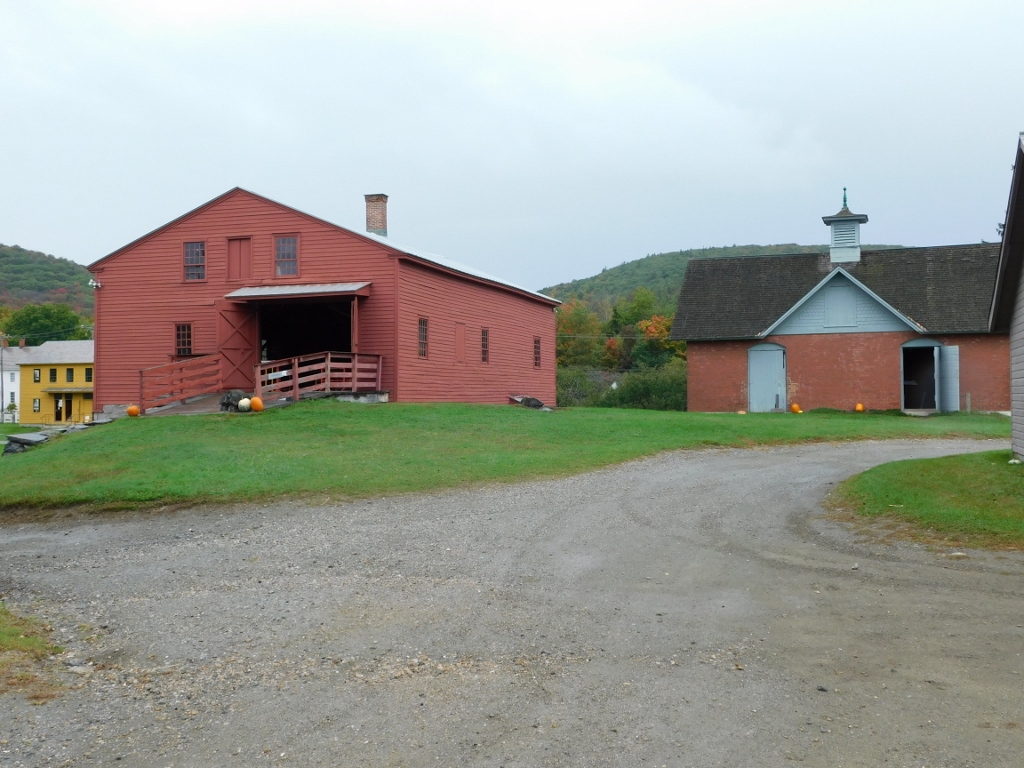 Tannery is to the left and the Ice House is to the right
Tannery is to the left and the Ice House is to the right
The structure called the Tannery was in fact used for different purposes, including also as the place for turning animal hides into leather, as well as the blacksmiths and woodworkers workshop.
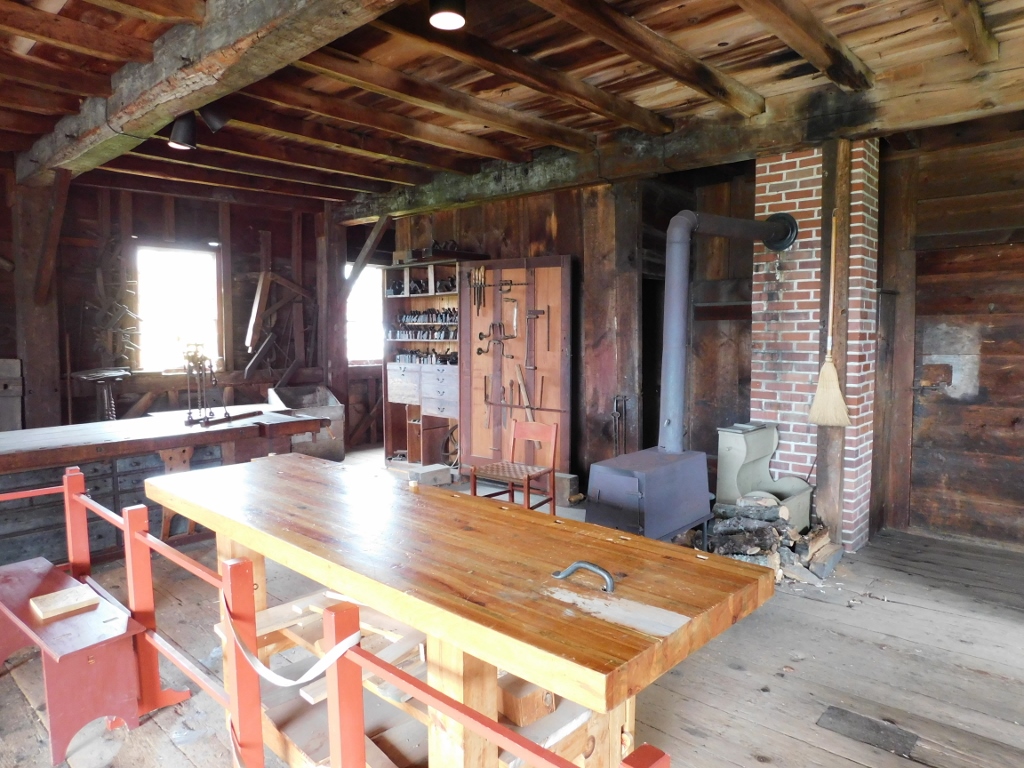 Tannery, a detail
Tannery, a detail
As for the Ice House, the one seen here today was built in 1894, when it replaced the previous one from 1866. The ice houses were necessary at the time when there were no fridges to keep the food in the cold, making sure that it was safe for eating. In addition, since the livelihood of the Shakers depended on their production of milk and milk products, it was necessary that they had a building that would provide their cold storage. This building was made in such a way that 200 tons of ice, which was the quantity it could store, would do their function for a whole year.
From a mild elevation in front of the Tannery and the Ice House I had again a fine view at the Round Stone Barn.
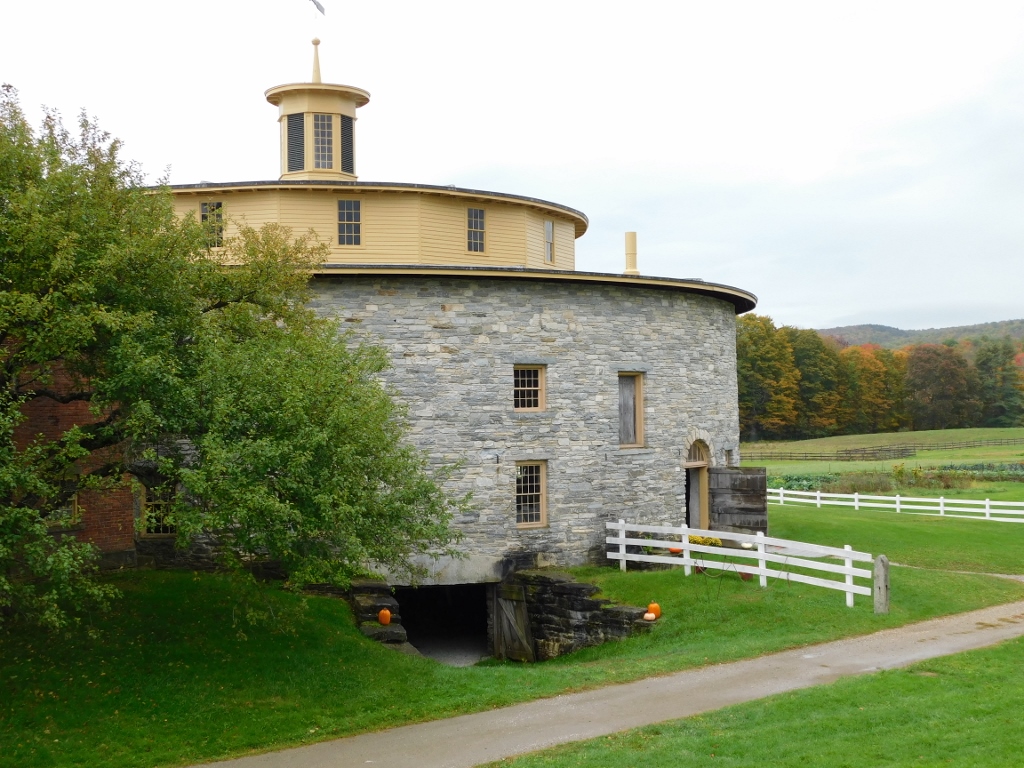 Round Stone Barn
Round Stone Barn
Behind the Ice House, there is the Hired Men’s Shop. Namely, albeit not gladly, ever since 1826, the Shakers occasionally had to hire workers (e.g., stonemasons during the construction of the Round Stone Barn). Later this was necessary because of the lack of Brethren and consequently of the labour force, but the house used for the accommodation of the hired workers was located far enough not to disturb the normal functioning of the community. The house that can be seen here today actually used to be located farther away, but it was transferred here in 1905 in order to replace the one on this spot that had burned down in a fire.
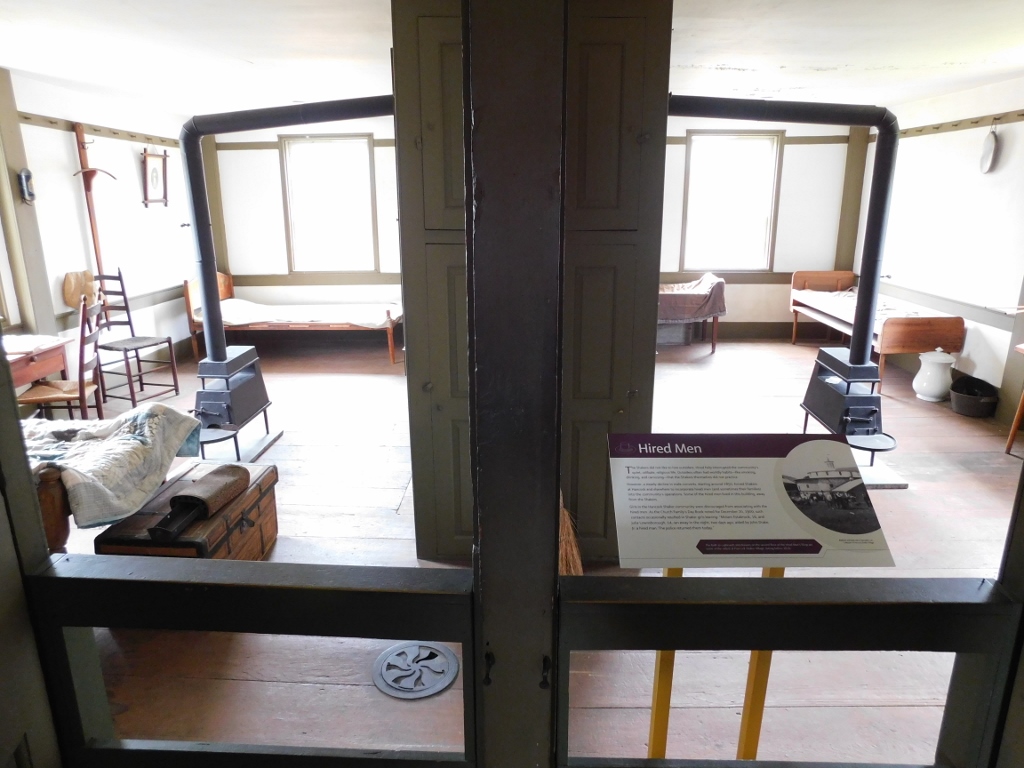 Hired Men’s Shop, a detail
Hired Men’s Shop, a detail
My favourite was still the Round Stone Barn, but I had already visited it, so with Daniela I just continued further.
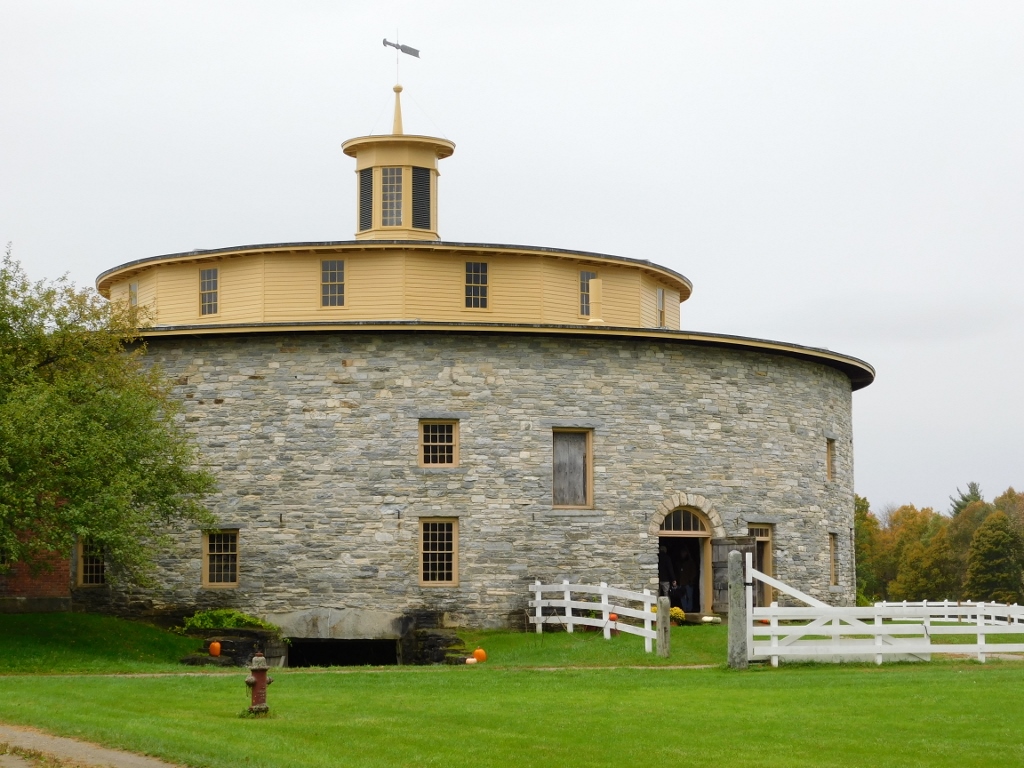 Round Stone Barn
Round Stone Barn
Thus the two of us reached two yellow buildings, with the one to the left being the Sisters’ Dairy & Weave Shop.
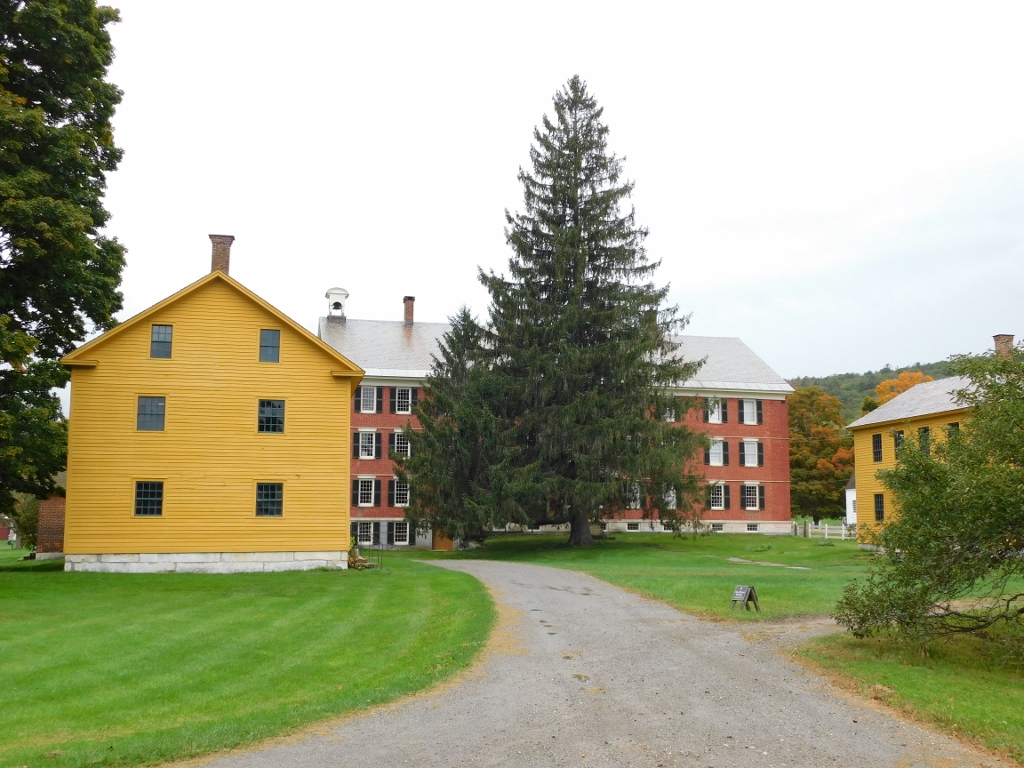 Hancock Shaker Village
Hancock Shaker Village
As its name says, this is where the Sisters used to make milk products, as well as where they did spinning and weaving. Namely, even when it was possible to buy ready-to-use cloth, the Shakers insisted on making their materials themselves which they then used for the sewing of clothes and bedding.
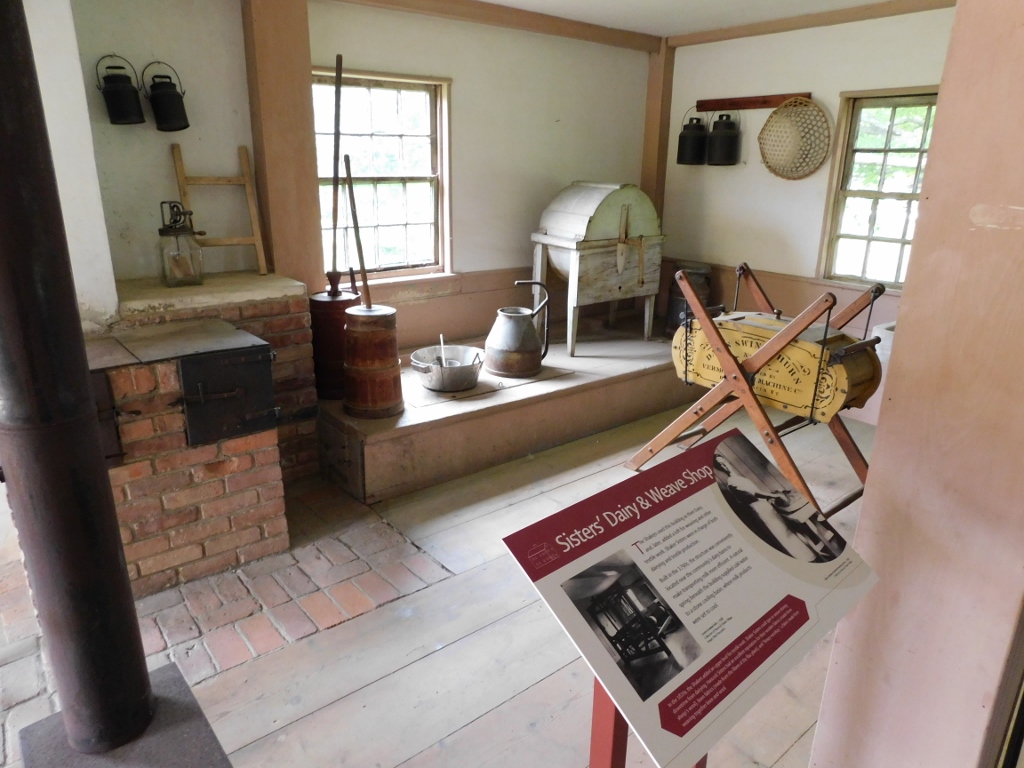 Sisters’ Dairy & Weave Shop, a detail
Sisters’ Dairy & Weave Shop, a detail
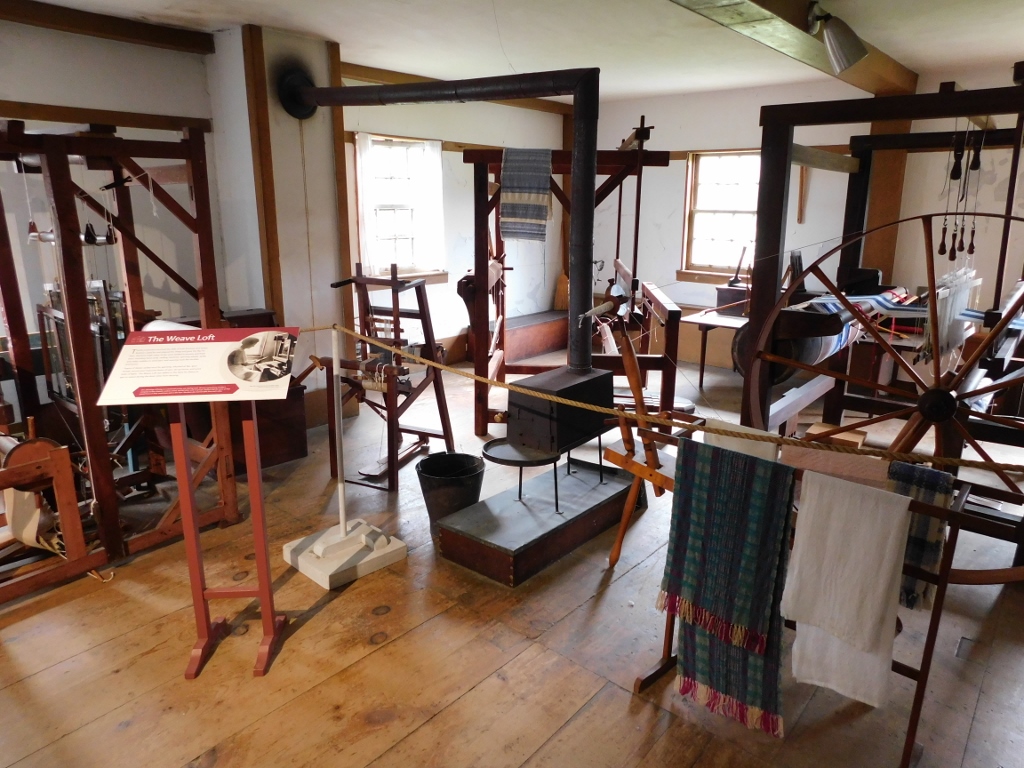 Sisters’ Dairy & Weave Shop, a detail
Sisters’ Dairy & Weave Shop, a detail
The second yellow house, that is practically the same as the one seen in the photo below, was built around 1812 and it served as a male workshop, which is reflected in its name – the Brethren’s Shop. This is where men made different objects that were mostly used within the community, but any surplus was sold. There were several male workshops on the property, depending on the craft that was done there, and this was the place where they made boxes and, as I learned here, very renowned Shaker chairs. To start with, I was impressed by the platform used for climbing carts that was installed in front of the Brethren’s Shop.
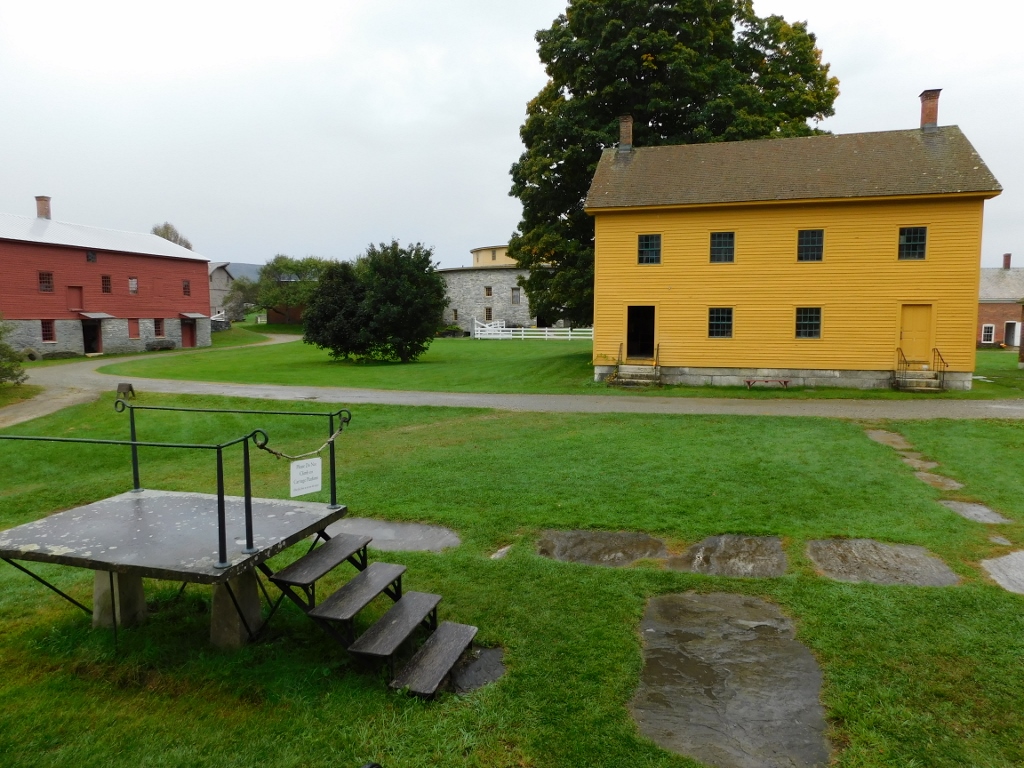 Platform and the Sisters’ Shop
Platform and the Sisters’ Shop
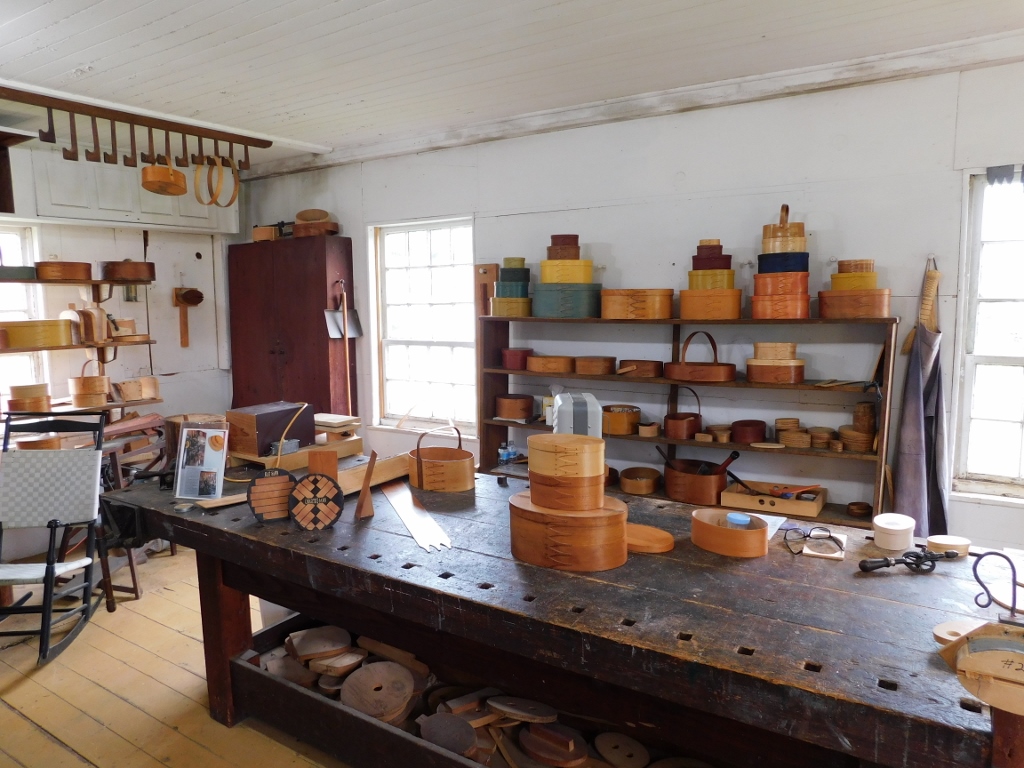 Brethren’s Shop, a detail
Brethren’s Shop, a detail
As for the chairs, they were, like the other products made at the property, primarily made for the needs of the commune, but over time they also became popular in the outside world. One of the Shaker communities started with the sale of chairs back in 1789 and because of the high demand even a chair factory was opened in 1872. Although they have a simple design, these chairs were made at an exceptionally high quality level, hence their big popularity.
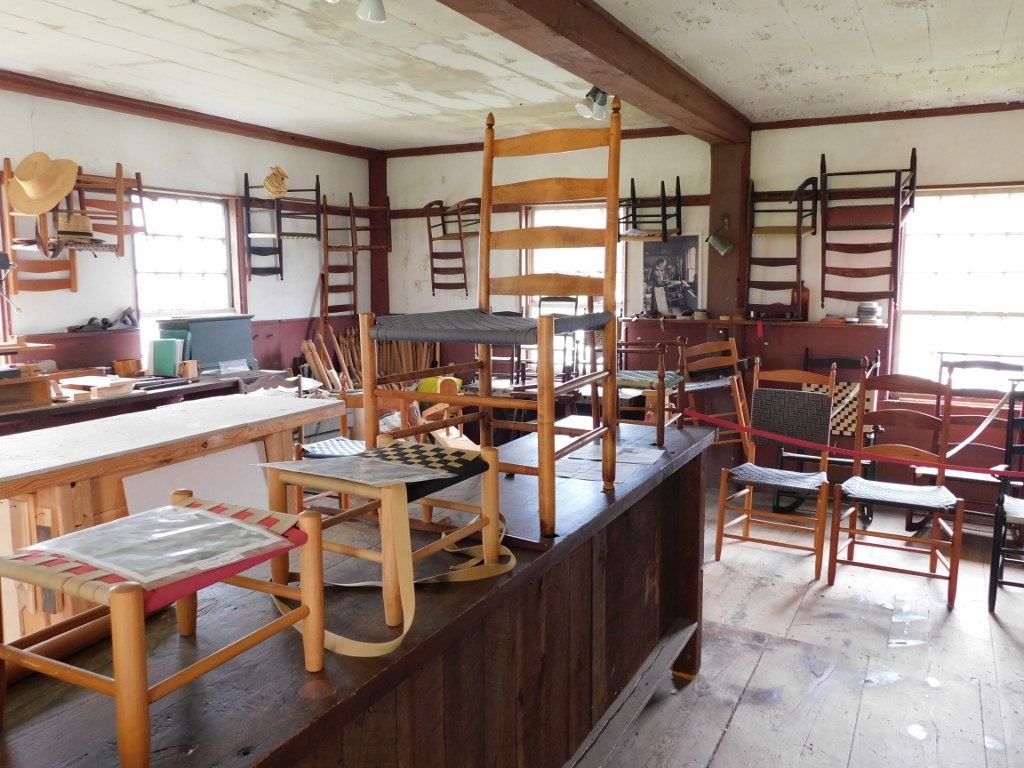 Brethren’s Shop, a detail
Brethren’s Shop, a detail
After the visit to this house, we crossed the asphalt road that cuts through this open-air museum.
 Hancock Shaker Village
Hancock Shaker Village
This part of the village on the other side of the regular road is smaller and there we first went to see the Horse Barn. Nearby there are also the Schoolhouse and Outbuildings, but we did not go there.
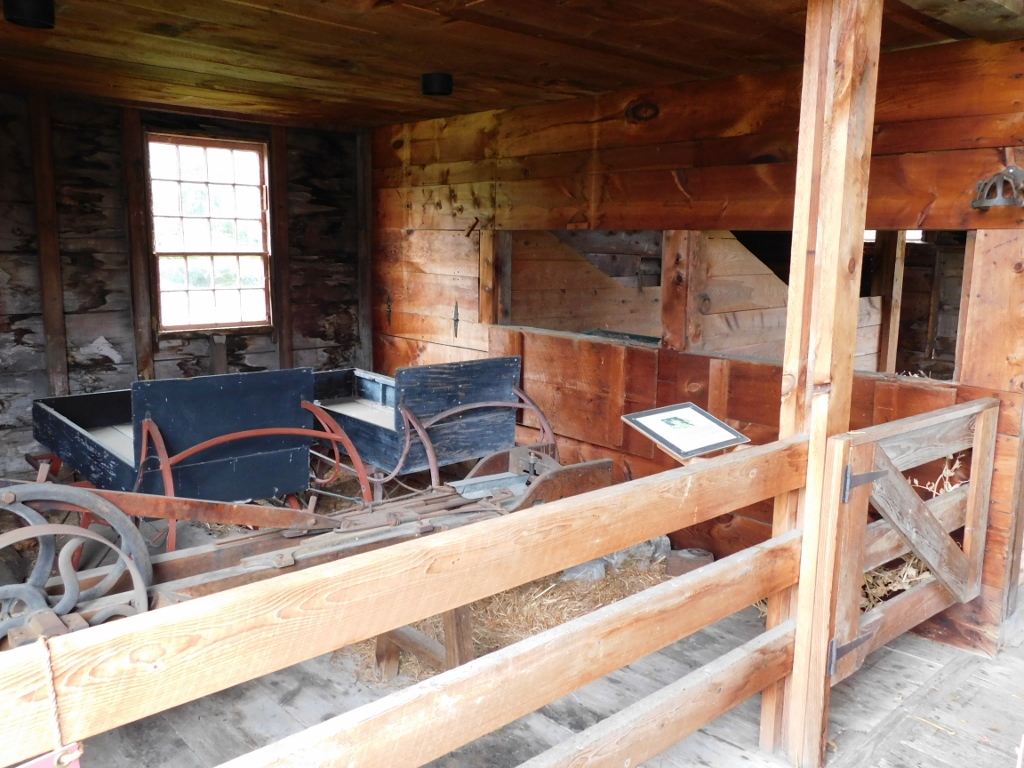 Horse Barn, a detail
Horse Barn, a detail
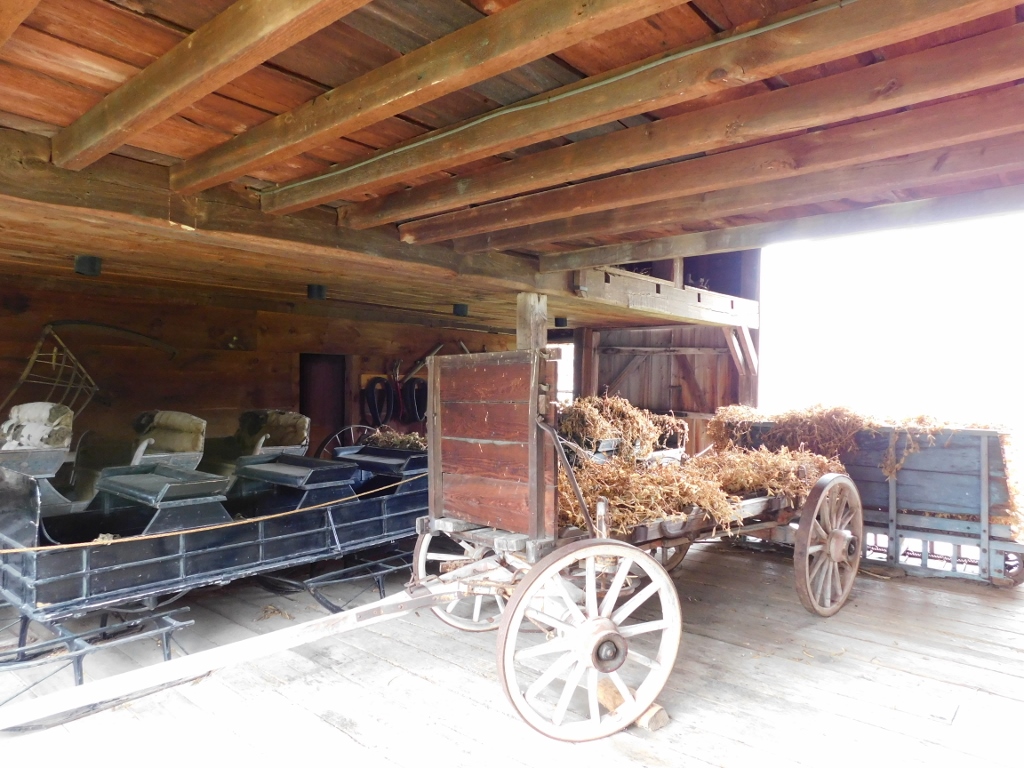 Horse Barn, a detail
Horse Barn, a detail
The two most important buildings on this side of the road are the Ministry Shop and the Meetinghouse.
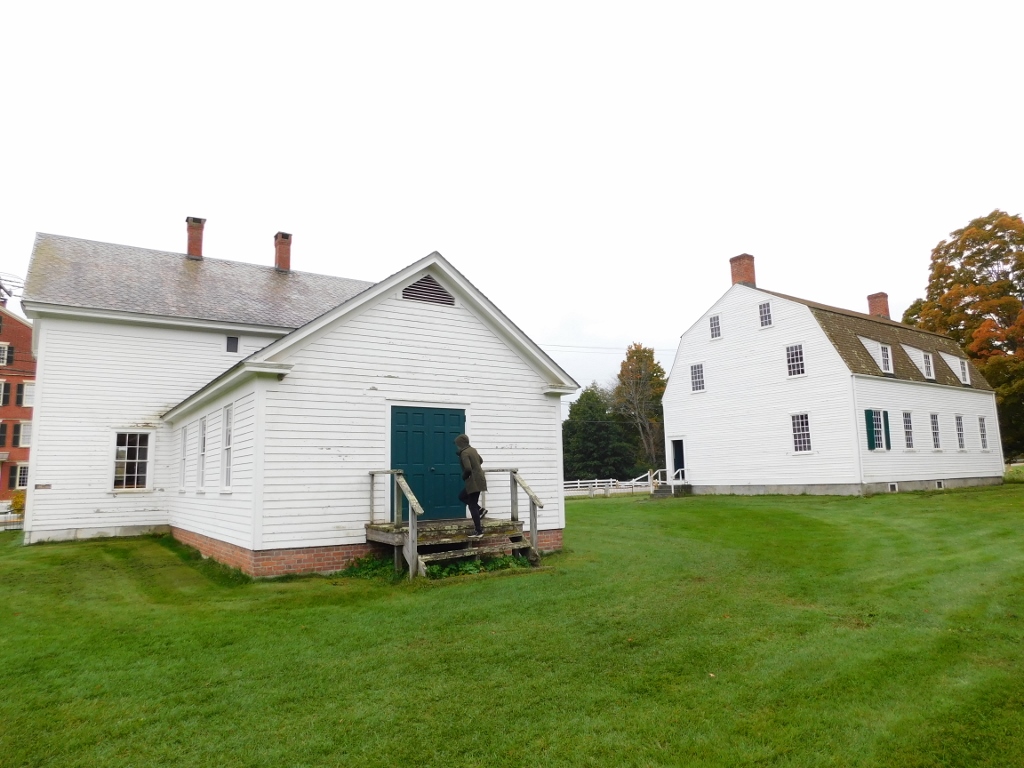 Ministry Shop, left, and the Meetinghouse, right
Ministry Shop, left, and the Meetinghouse, right
The Meetinghouse was used for the religious assembly and prayers. Two services were organised on Sundays – the morning one was open to public, with the hope that they may attract new members in this way, while the afternoon one was for the community members alone.
As for the Ministry Shop, there were sleeping quarters, but also rooms where different crafts were practiced, since diligence and hard work were an integral part of the daily life of all the members of the community.
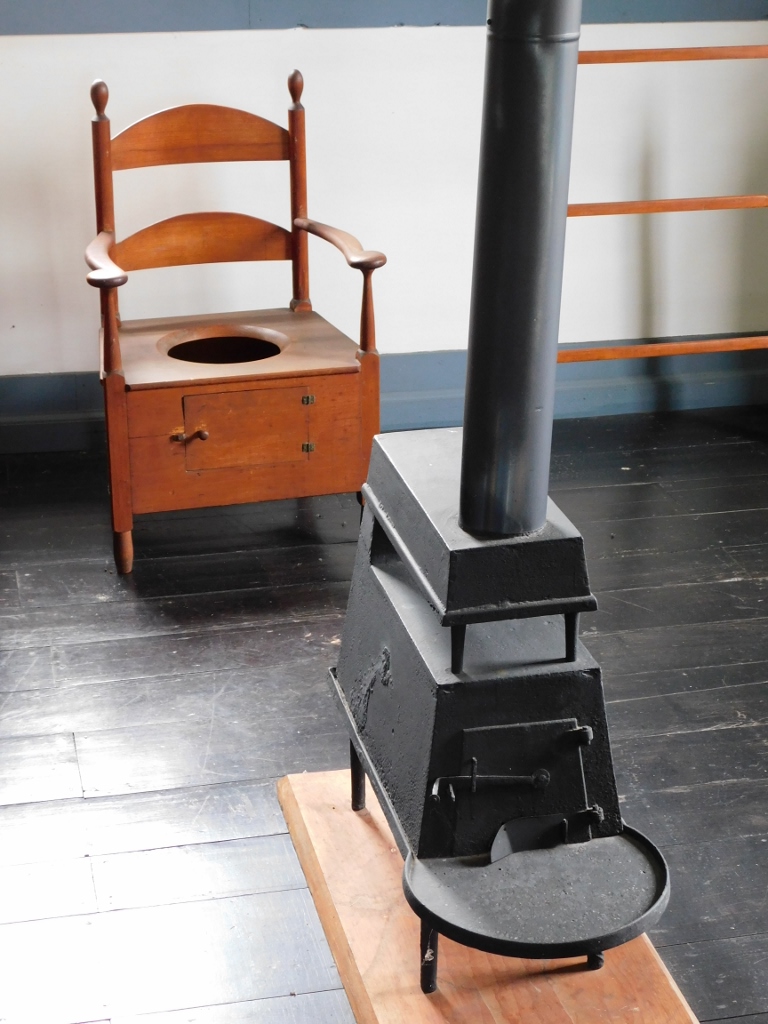 Ministry Shop, a detail
Ministry Shop, a detail
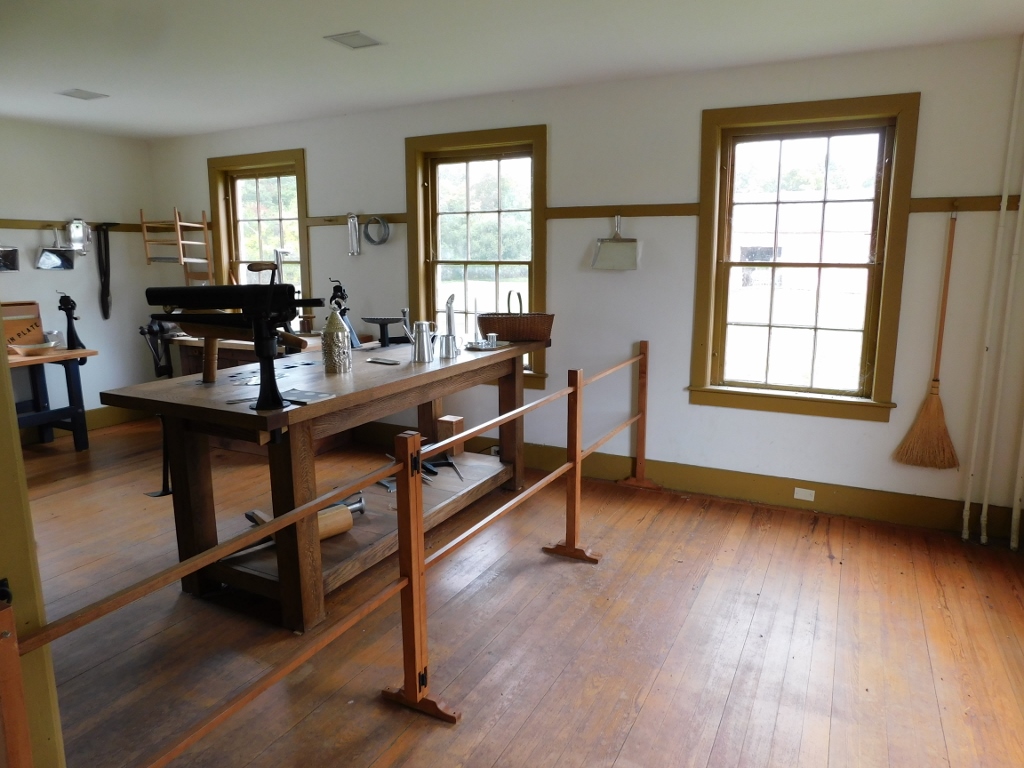 Ministry Shop, a detail
Ministry Shop, a detail
Daniela and I crossed the road again and returned to the main section of the Shaker village, since now we wanted to visit the biggest building and that was the red Brick Dwelling.
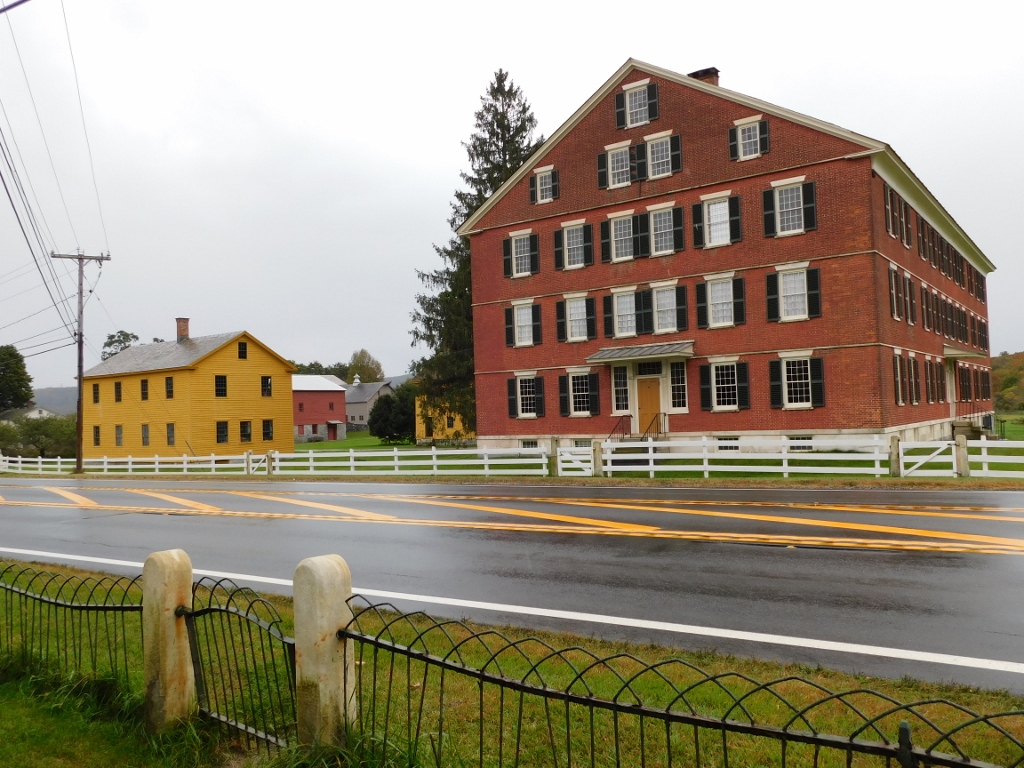 Brick Dwelling, to the right
Brick Dwelling, to the right
On the ground floor, among other things, there are the kitchen and the dining room.
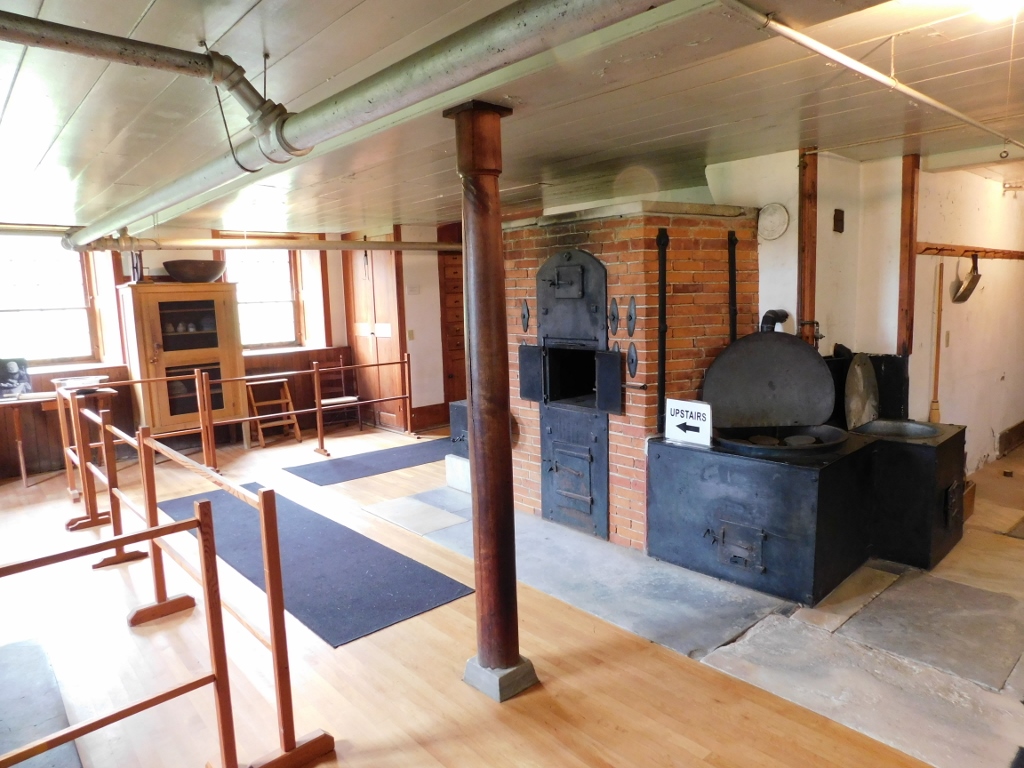 Brick Dwelling, a detail
Brick Dwelling, a detail
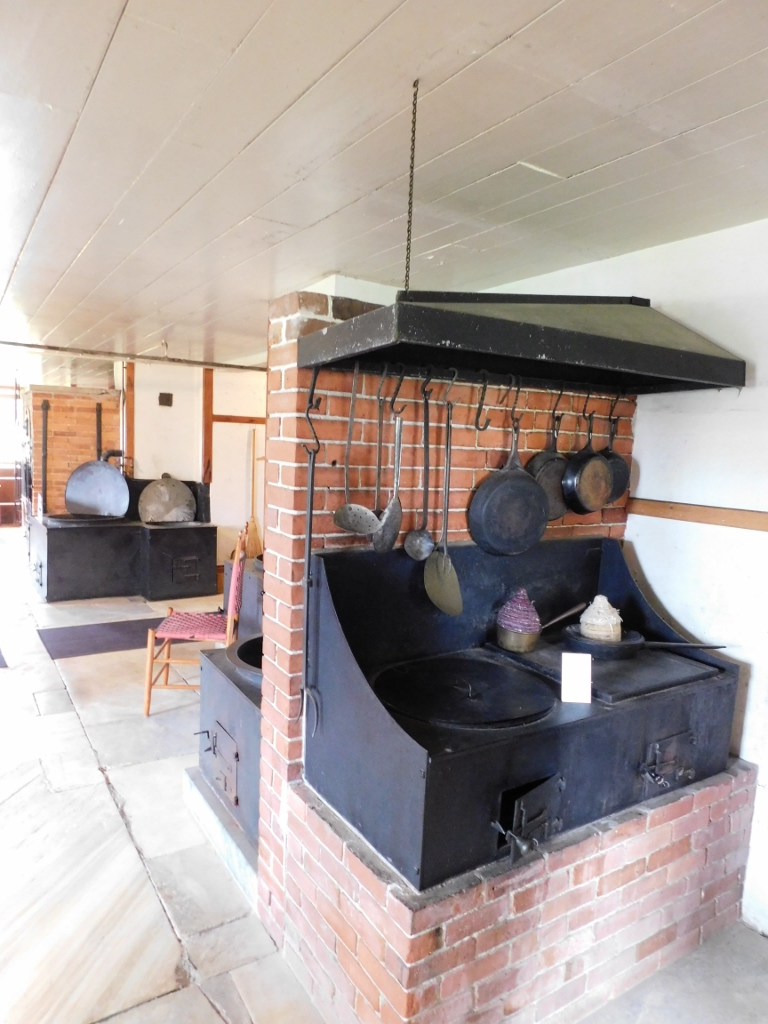 Brick Dwelling, a detail
Brick Dwelling, a detail
In the dining room, the Brethren sat on the east side and the Sisters on the west. After the prayer, the meals went on in silence. The Shakers were hardworking, but they also ate very well. It is well-known that they were encouraged to take as much food as they wanted, but it was also expected that they would eat everything they had put onto their plates.
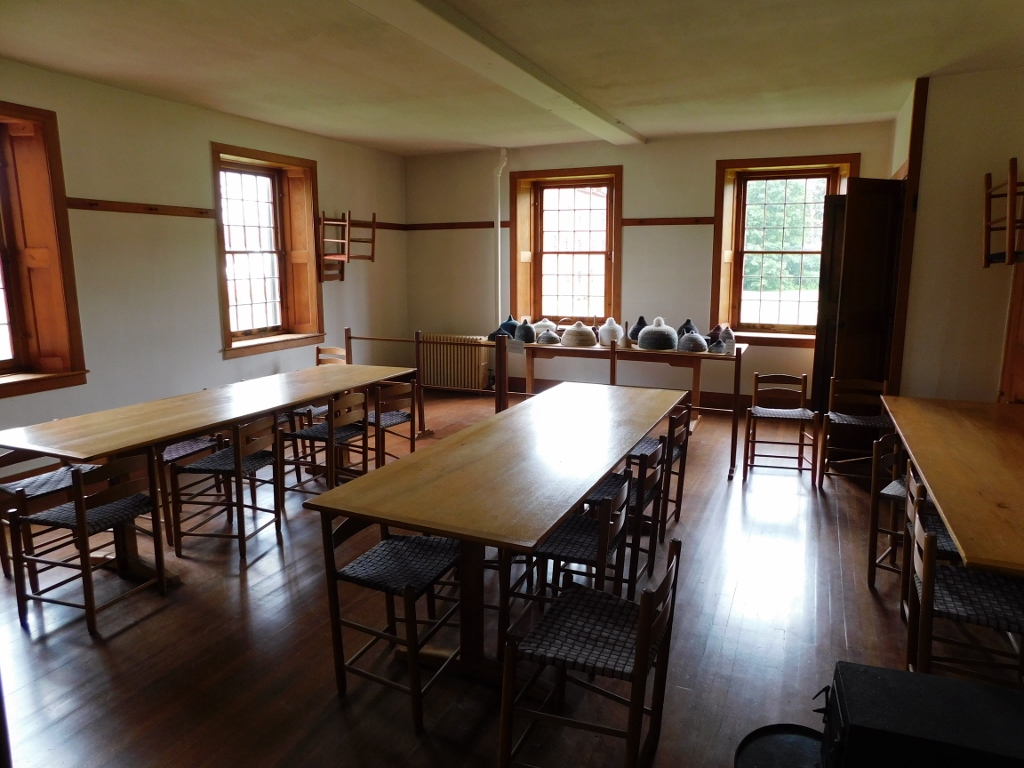 Brick Dwelling, a detail
Brick Dwelling, a detail
On the upper floors, there were the sleeping rooms which were, of course, divided into male and female, although they were all under the same roof.
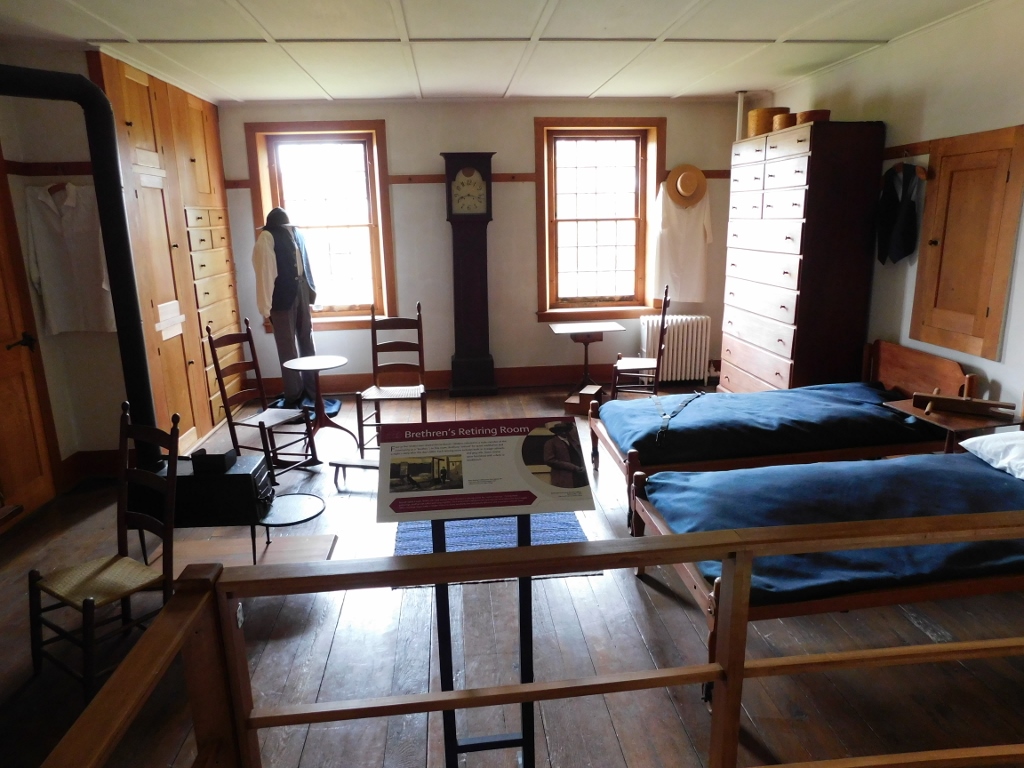 Brick Dwelling, a detail
Brick Dwelling, a detail
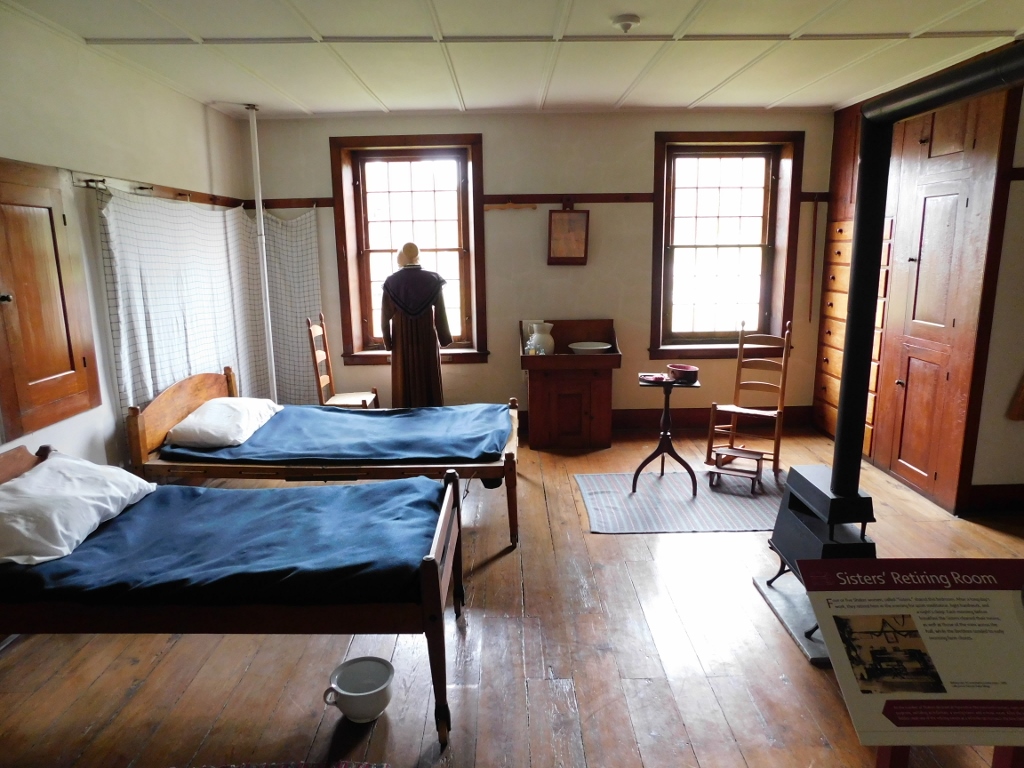 Brick Dwelling, a detail
Brick Dwelling, a detail
I have already mentioned that the gender equality was an integral part of the Shaker way of life. What is, however, particularly interesting is that from the very founding of their religion they also welcomed new members irrespective of their race, colour, disability or financial state. This was not an easy thing in all places, and here I think of the skin colour in particular, but the Shakers mostly lived in line with what they preached.
I have also mentioned that the celibacy was an important part of the life within the Shaker communities. And yet, in the Brick Dwelling you can see cradles for small children and I have already mentioned that there was a school here. How come?
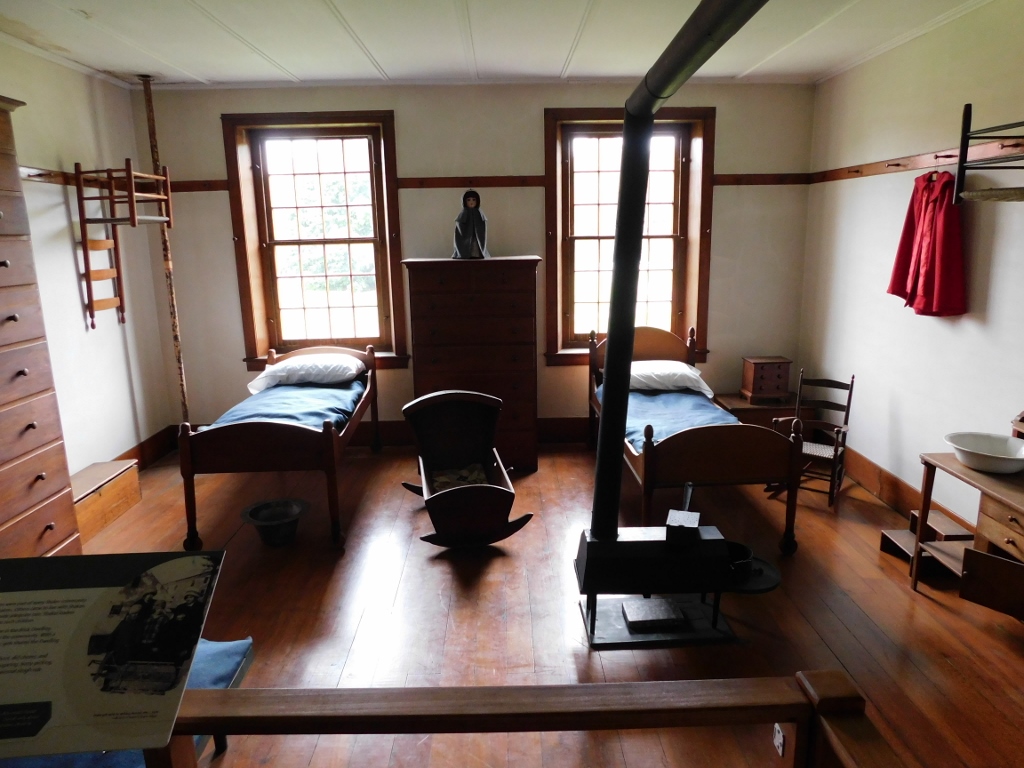 Brick Dwelling, a detail
Brick Dwelling, a detail
The children came here, for instance, with parents who had embraced the Shaker way of life. Or, these were the children who had become orphans or who came from such poor families that these could not raise them. The Shakers would then sign a contract under which they would take it upon themselves to feed, dress and educate these children. It is especially interesting that the Shaker children, once they came of age, had the right to choose whether they would remain in the community or leave for „the World“, as the Shakers called the world outside the community. According to the data, on an average around 10% of the children remained in the community as adult members.
But, in addition to working, eating and praying, people also get ill. The Shakers had a solution for that, too, and they were mostly self-sufficient. A small number of Shakers was sent outside the community in order to learn dentistry and surgery, while physicians from the outside world were called in only in emergencies. The Shakers had their nurse shops, practicing a holistic approach to health and applying plant preparations. They also invented various aids – such as a four-legged walker or cradles for adults that can be seen in the photo below.
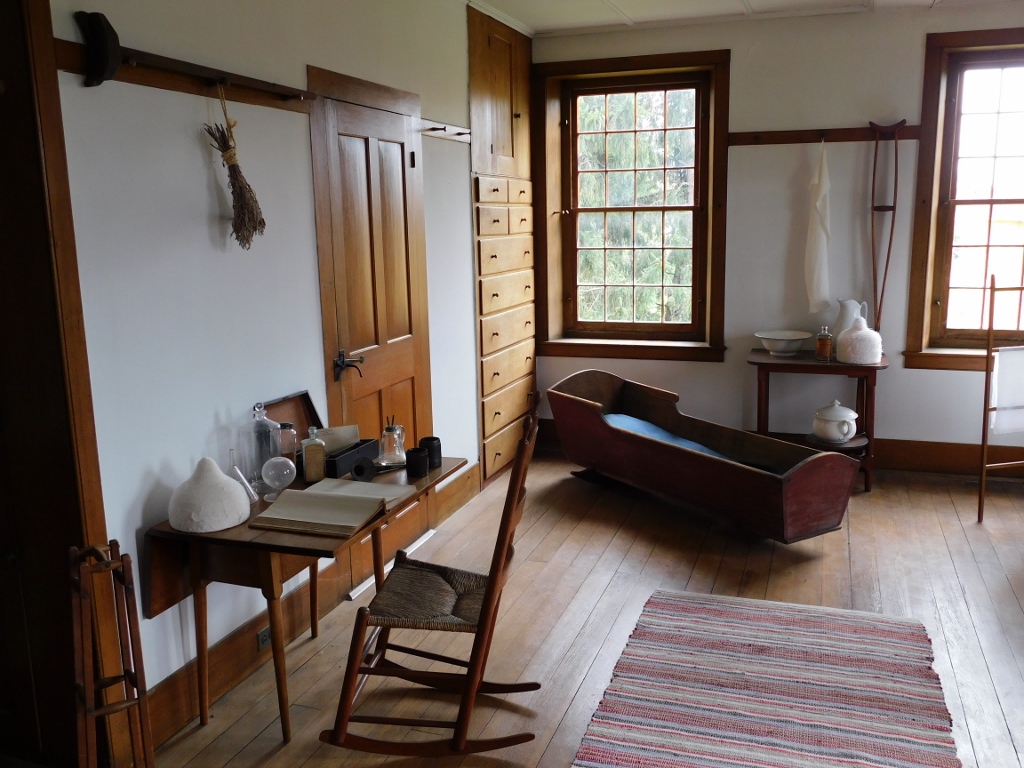 Brick Dwelling, a detail
Brick Dwelling, a detail
As for the cultivation of plants and the preparation of tinctures, the Shakers were renowned for their knowledge of this field and some of the Shaker communities have made a proper business by selling plant preparations to “the World.”
 Hancock Shaker Village
Hancock Shaker Village
 Hancock Shaker Village
Hancock Shaker Village
After the visit to the Brick Dwelling, we returned to the visitor path and by now there was only one more building to visit. This was the red building called the Laundry and Machine Shop.
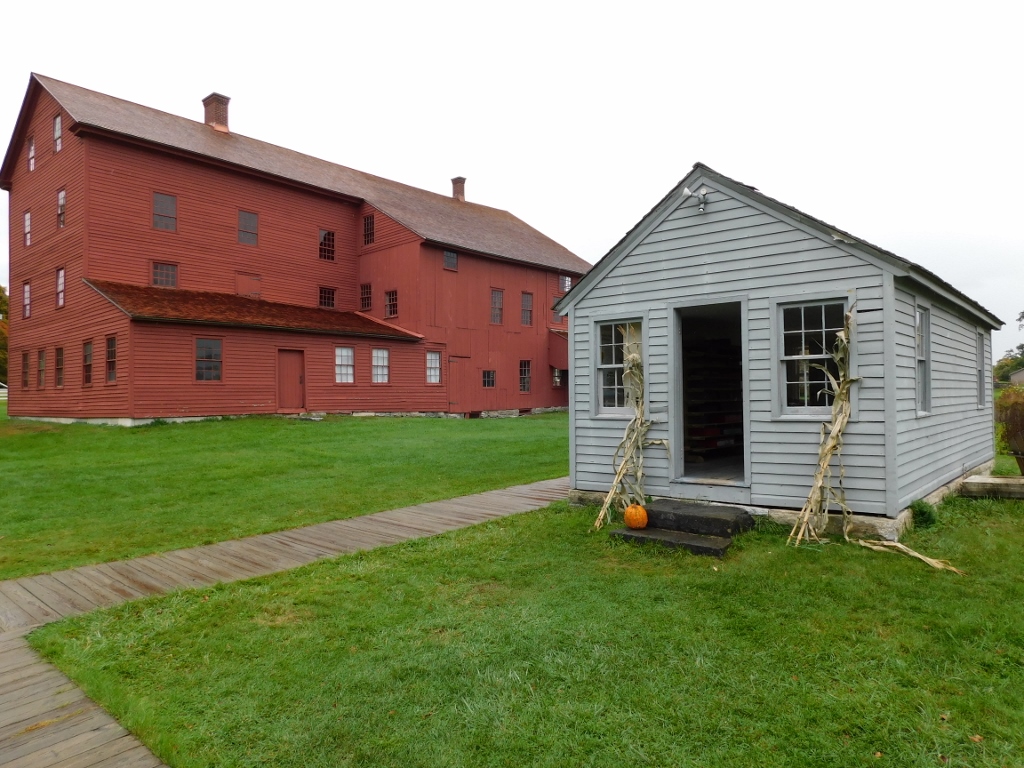 Laundry and Machine Shop (left)
Laundry and Machine Shop (left)
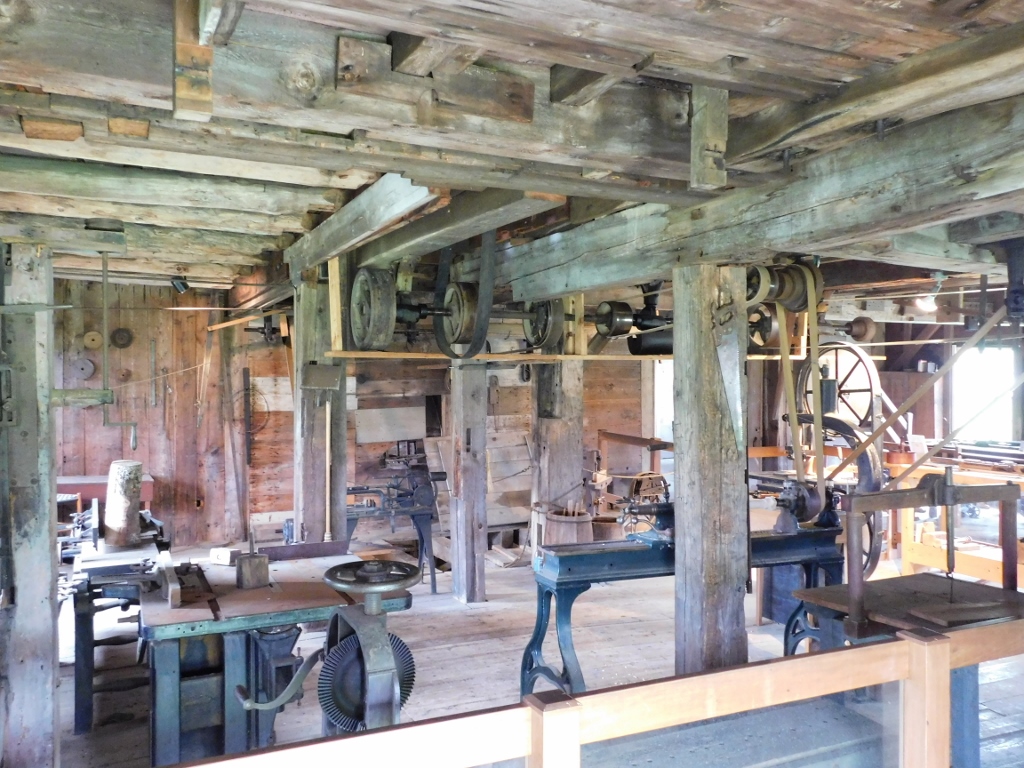 Laundry and Machine Shop, a detail
Laundry and Machine Shop, a detail
And now, Daniela and I headed back towards the Visitor Centre, as we were ready to continue with our trip. Before finally leaving this very interesting open-air museum, I just looked around some more taking photos of various interesting and picturesque details.
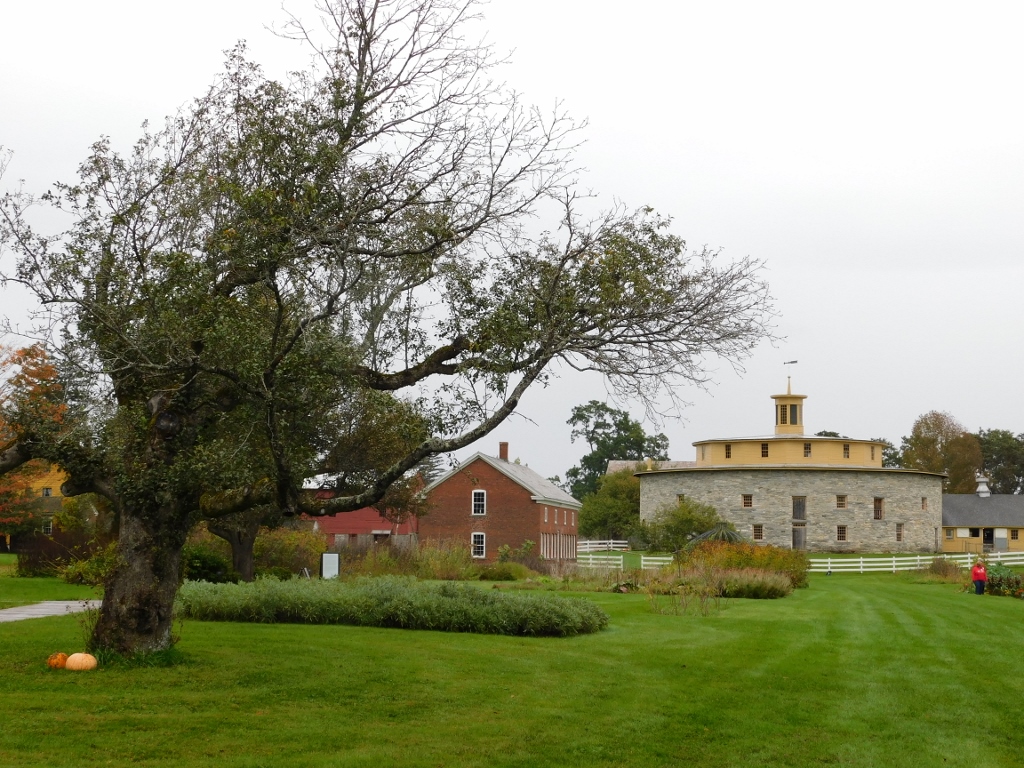 Hancock Shaker Village
Hancock Shaker Village
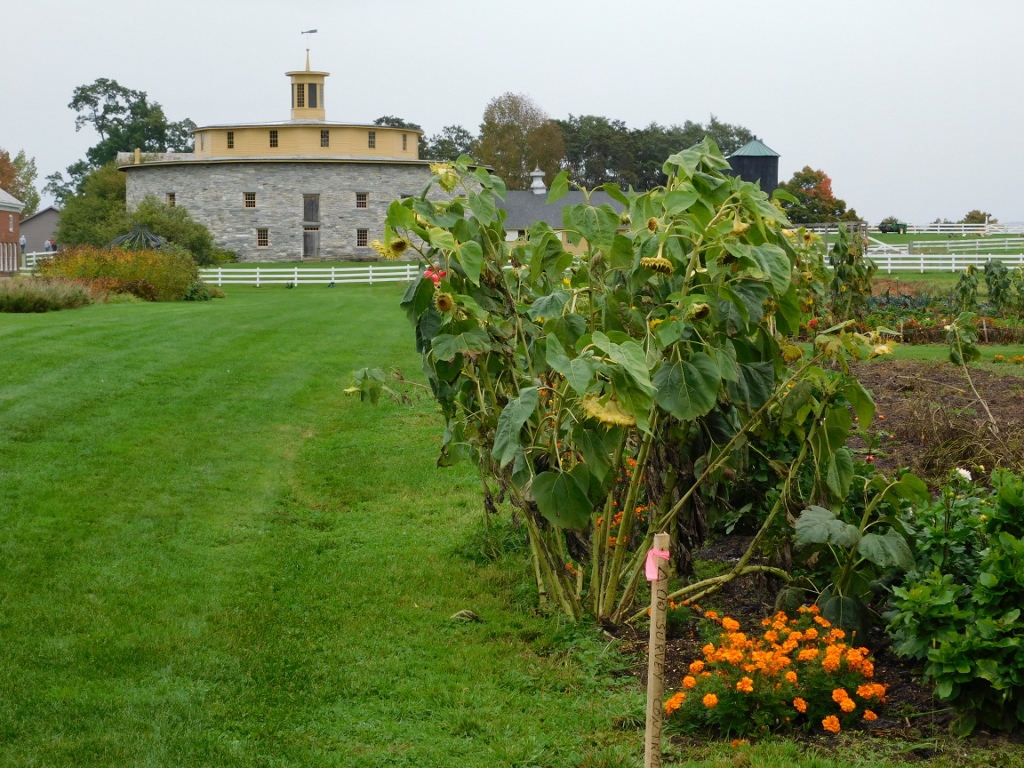 Hancock Shaker Village
Hancock Shaker Village